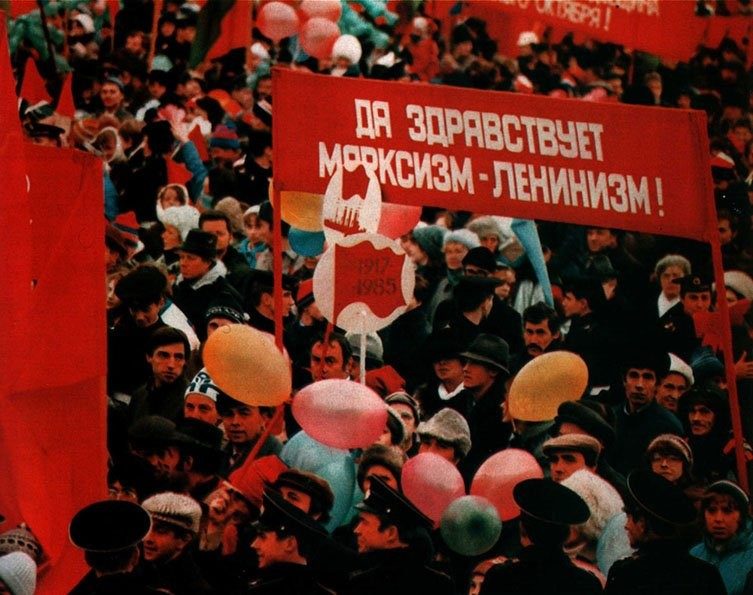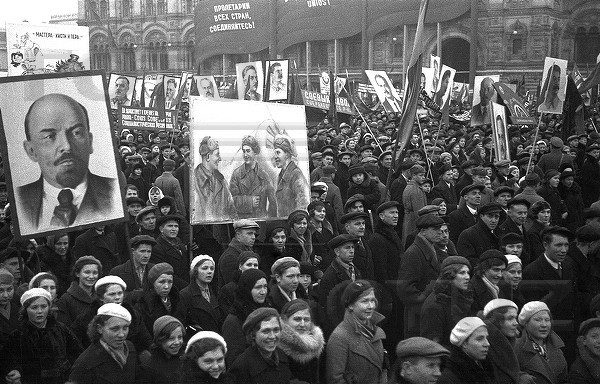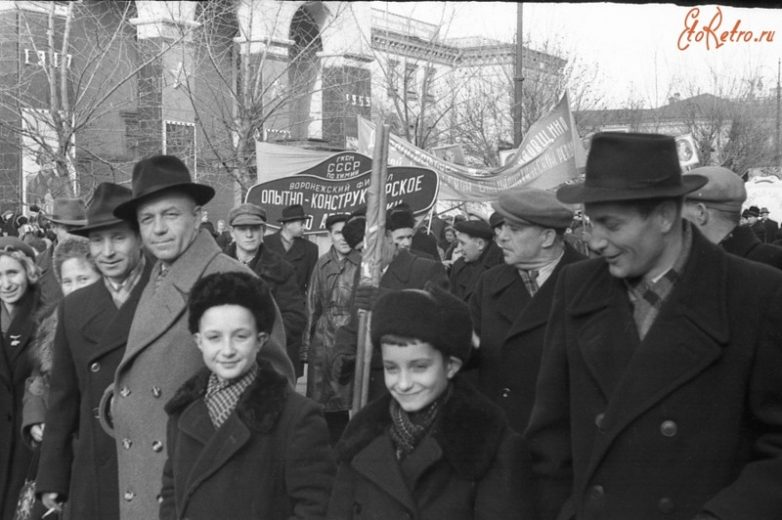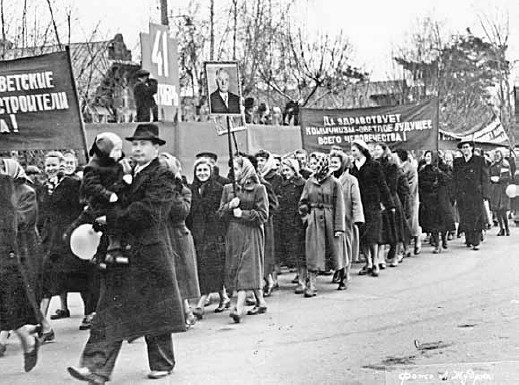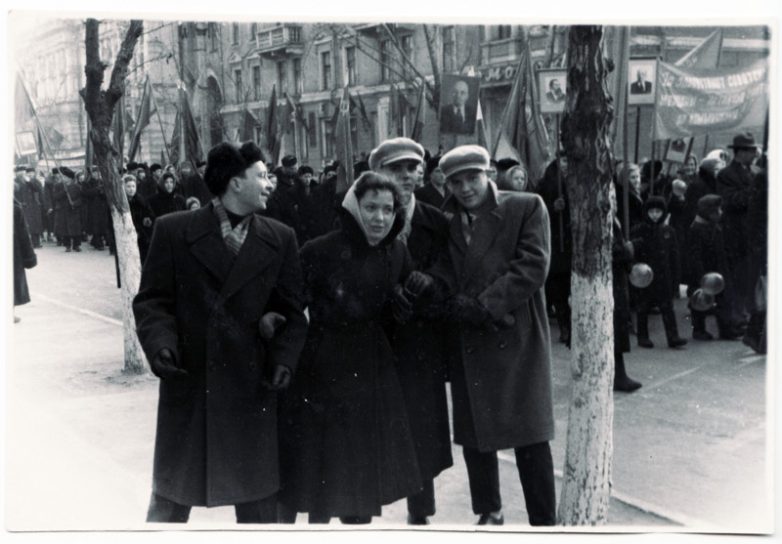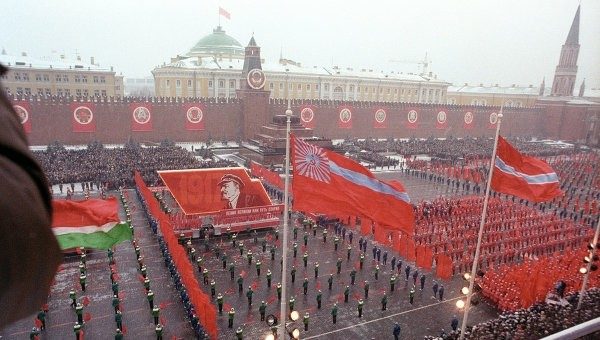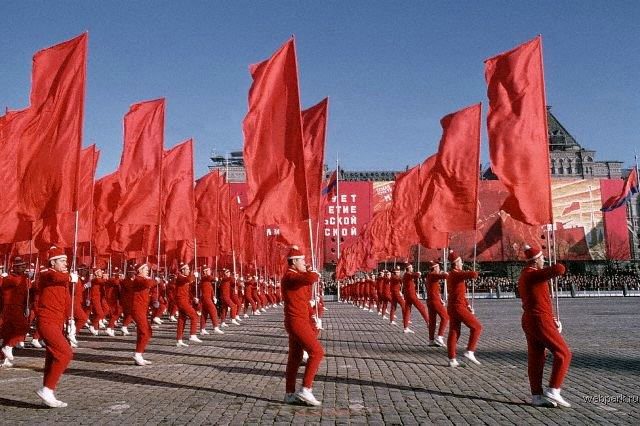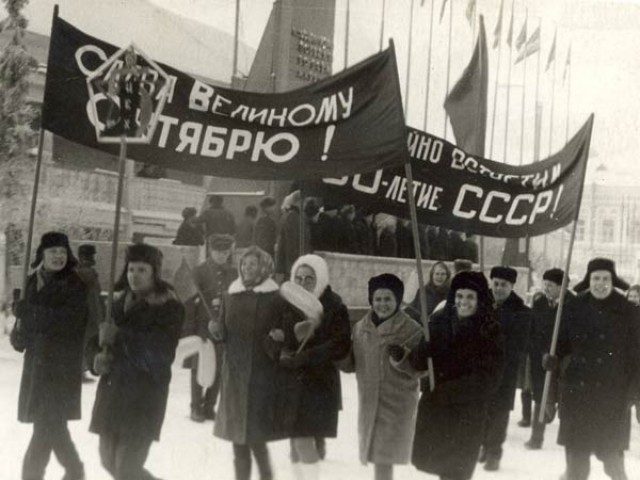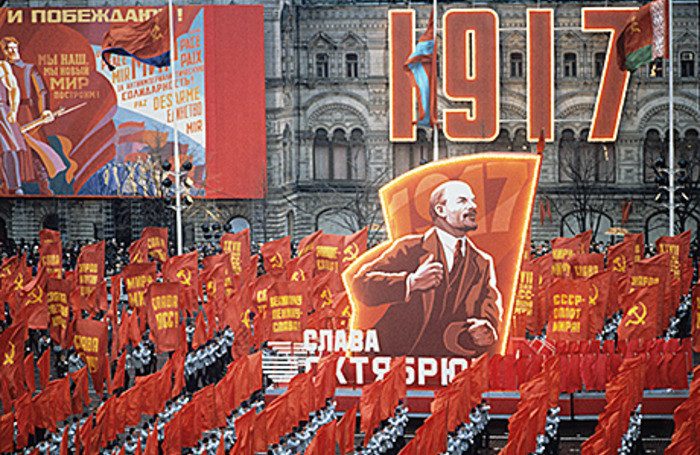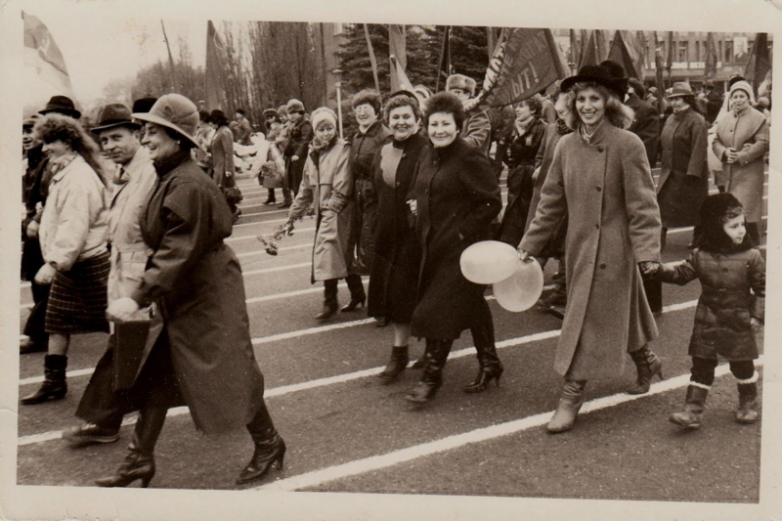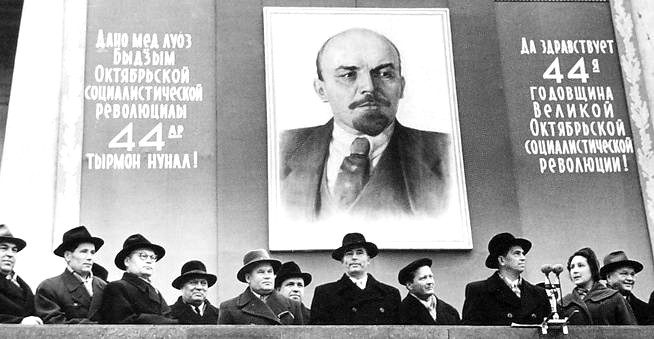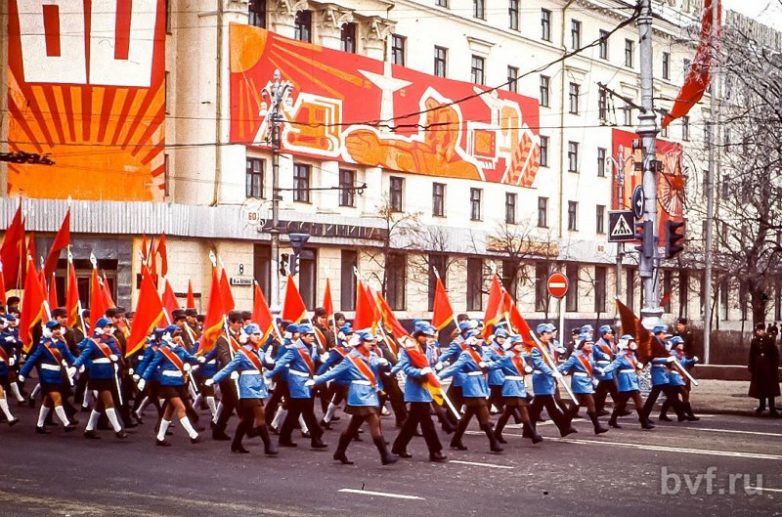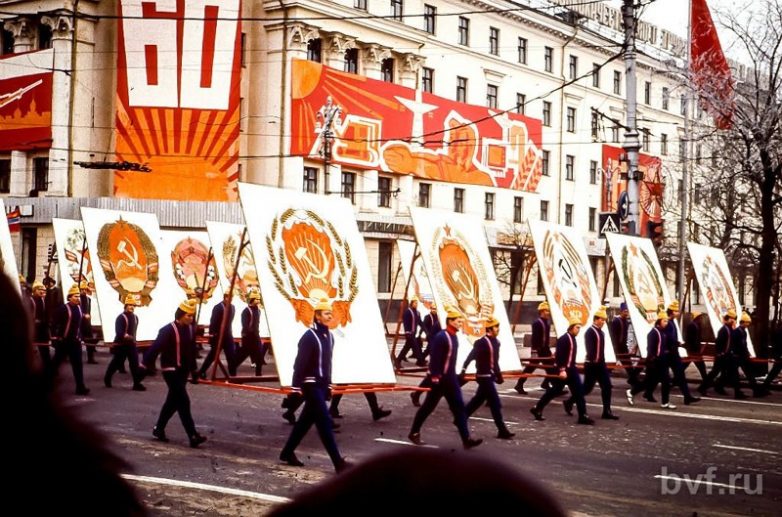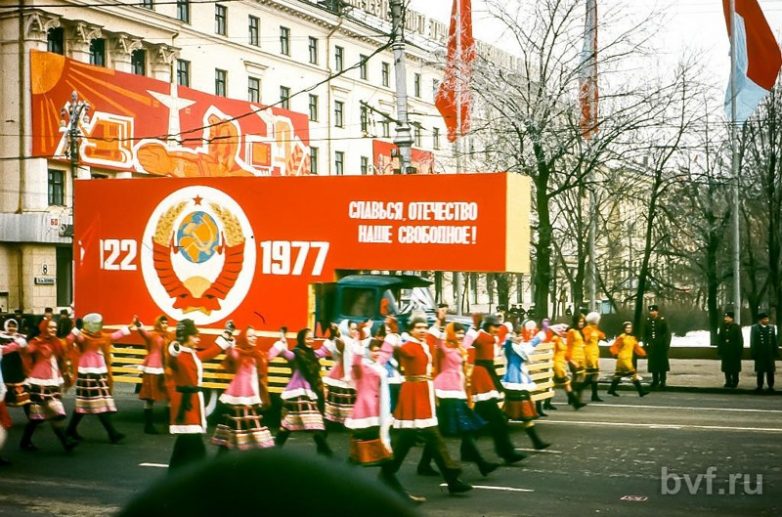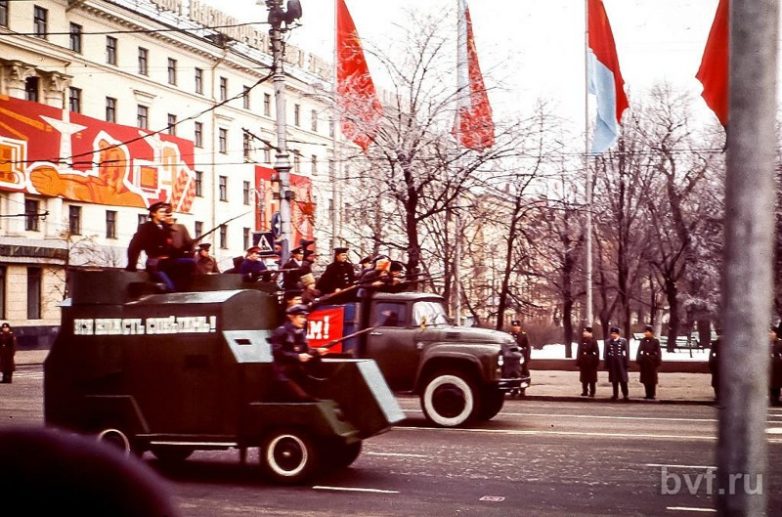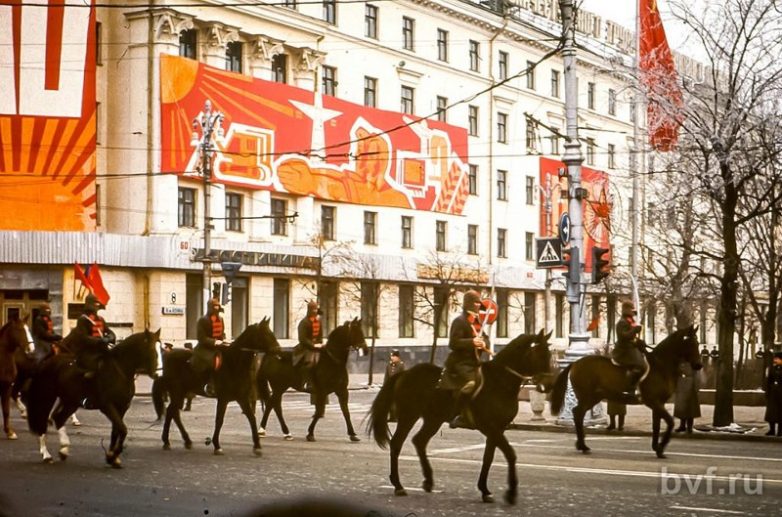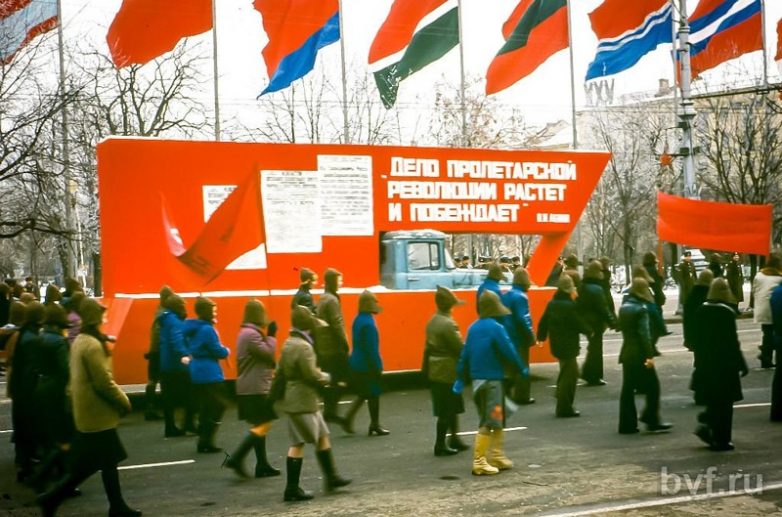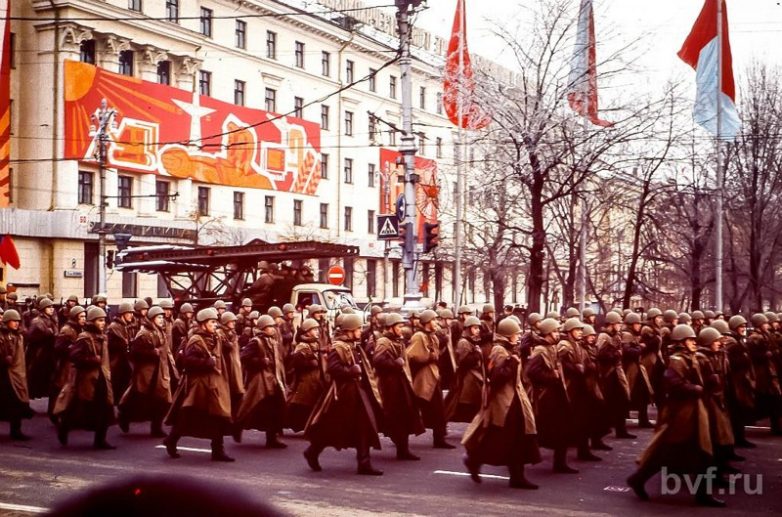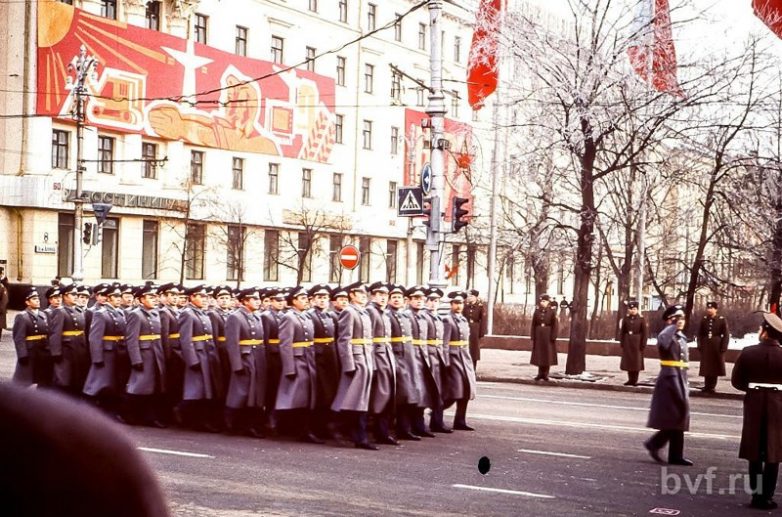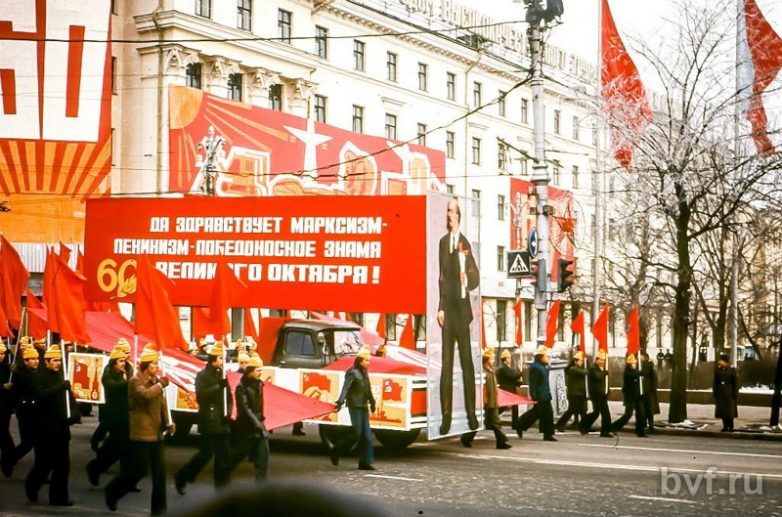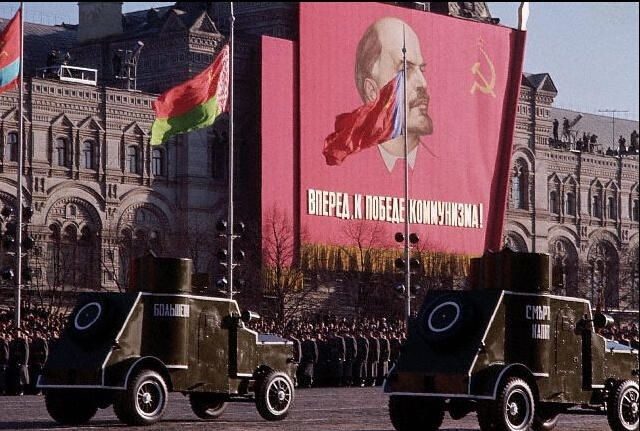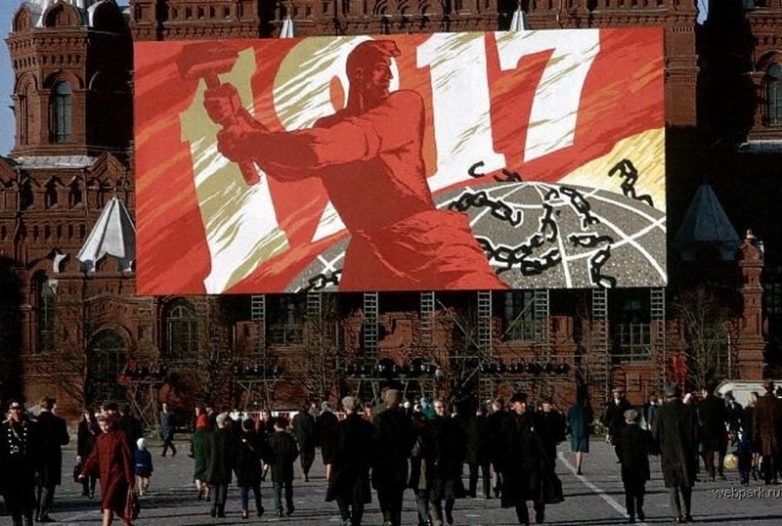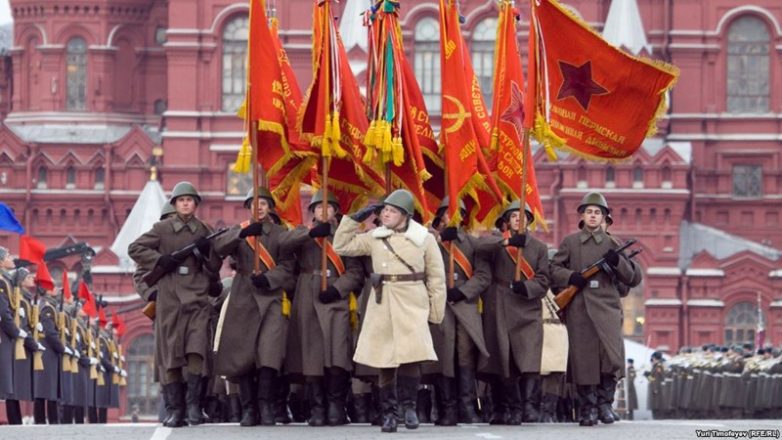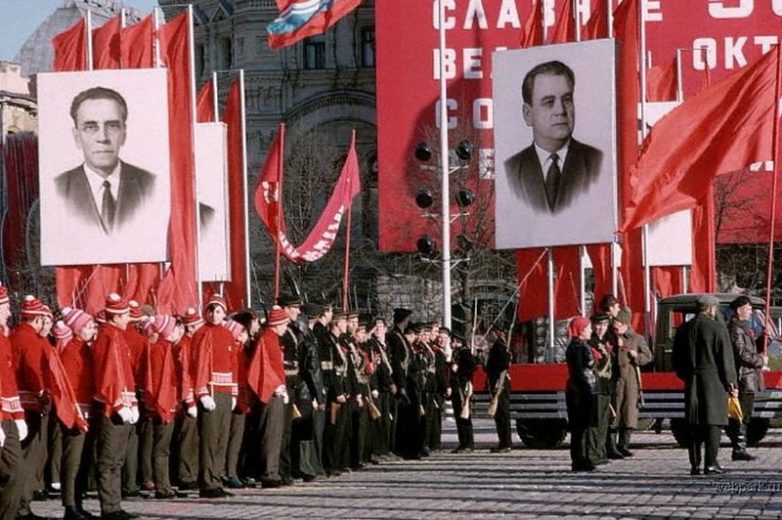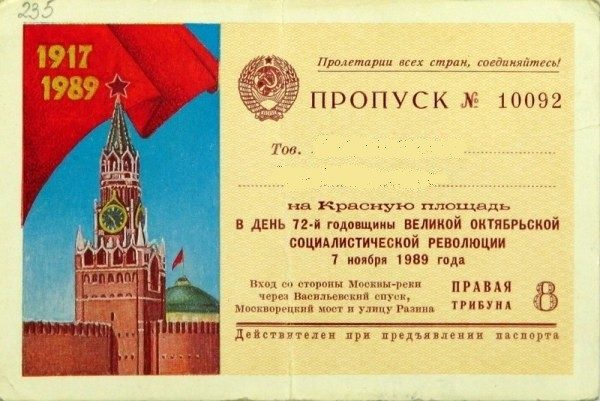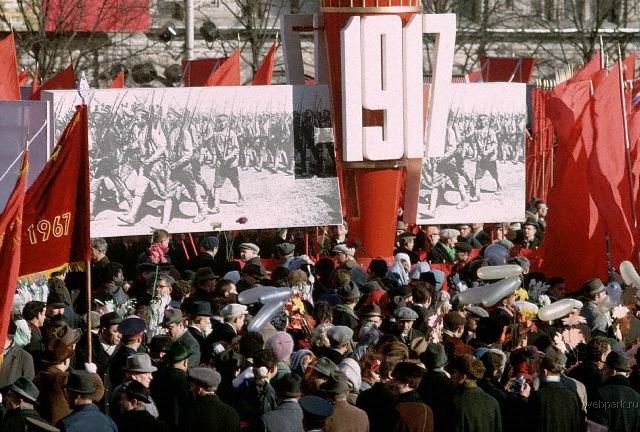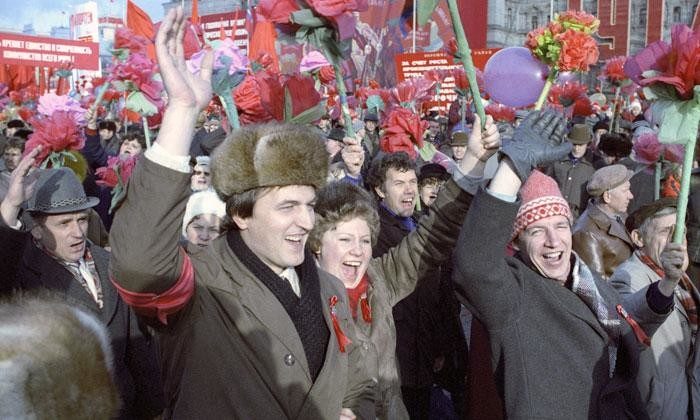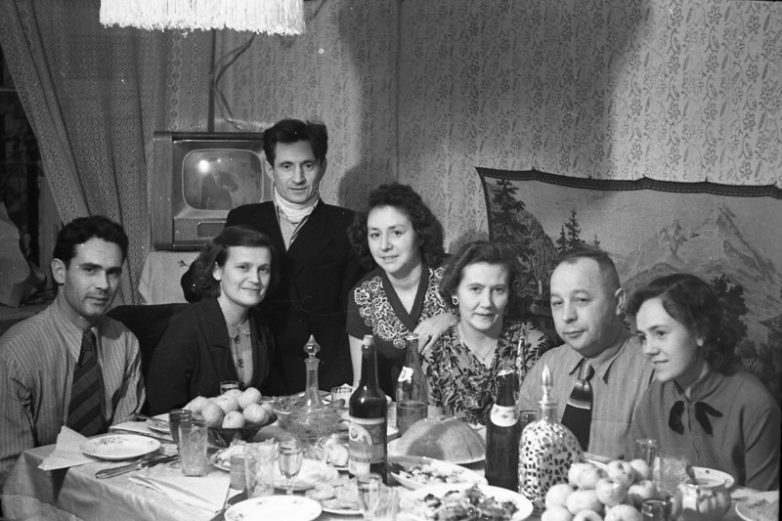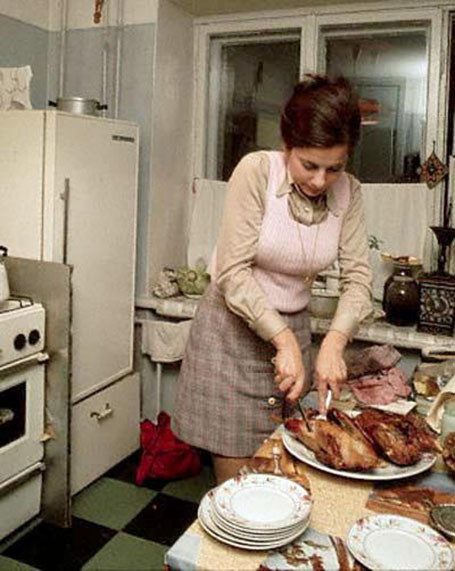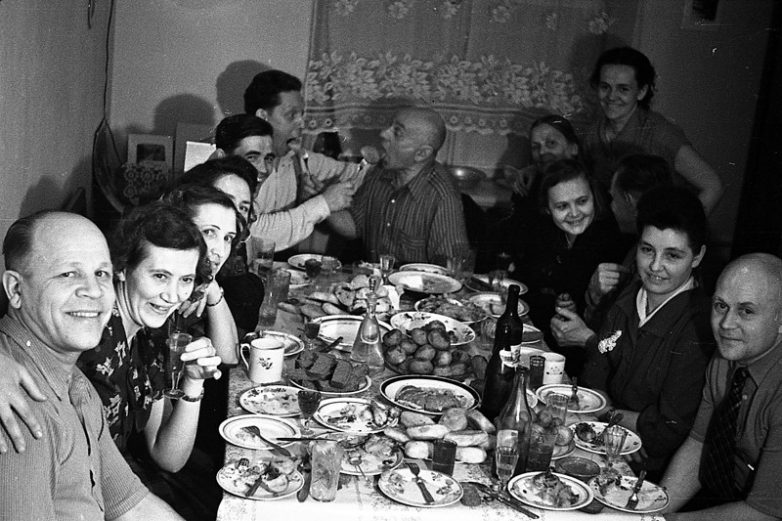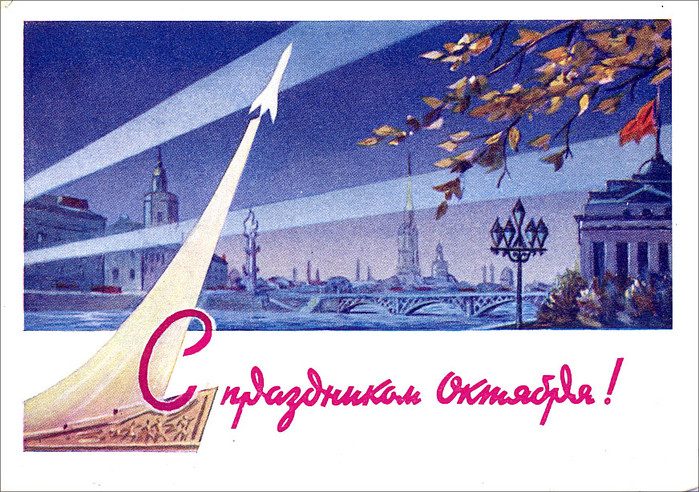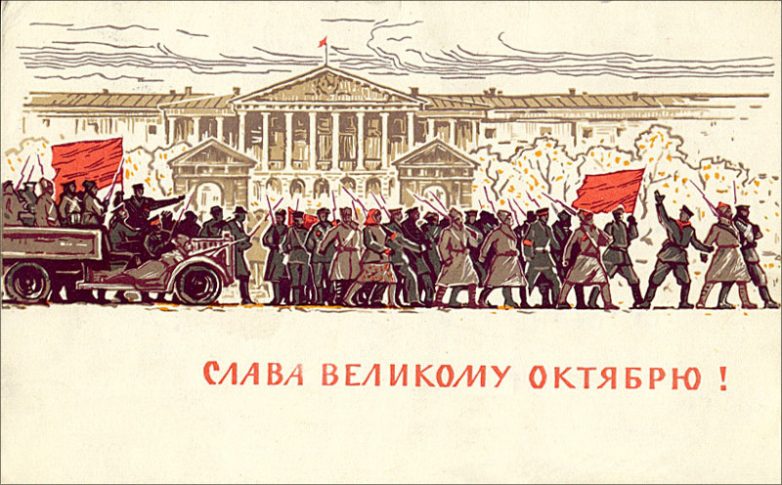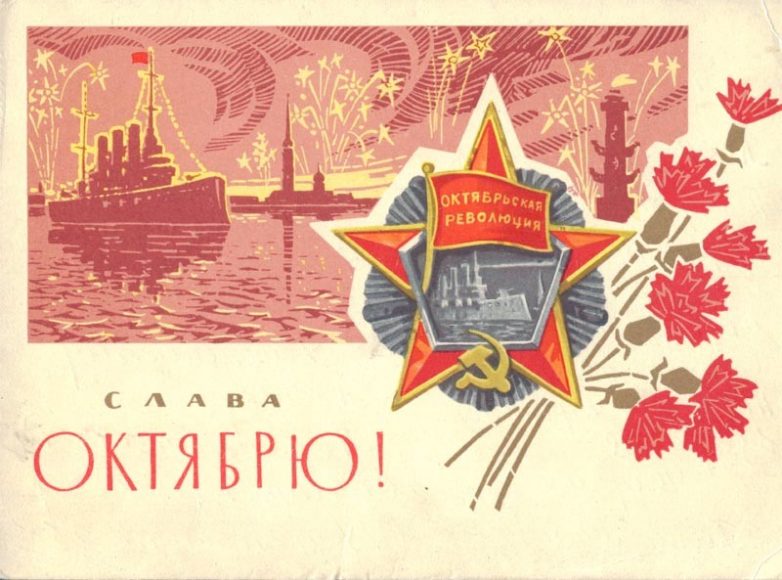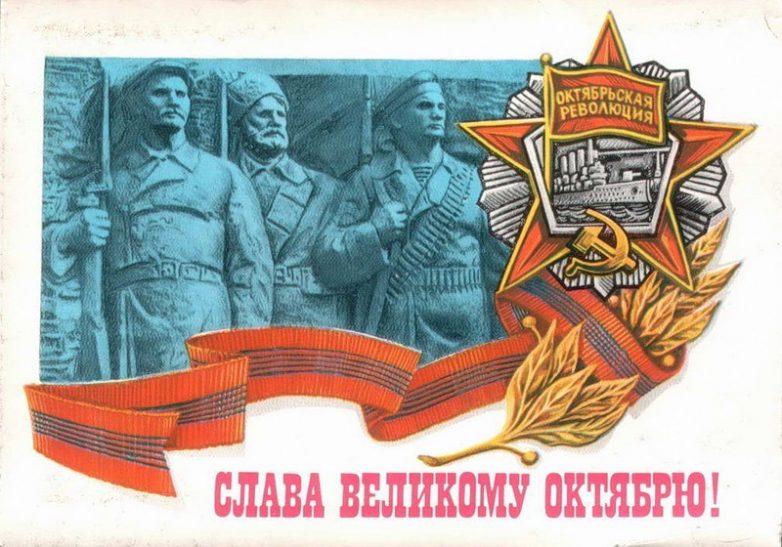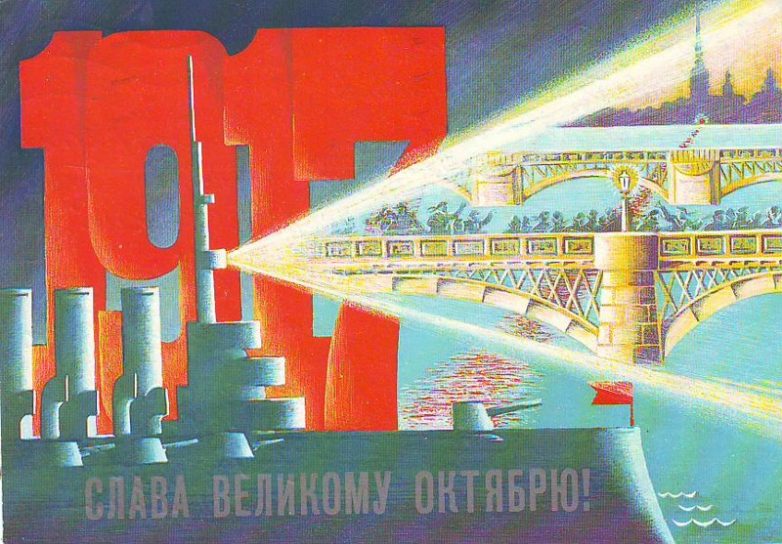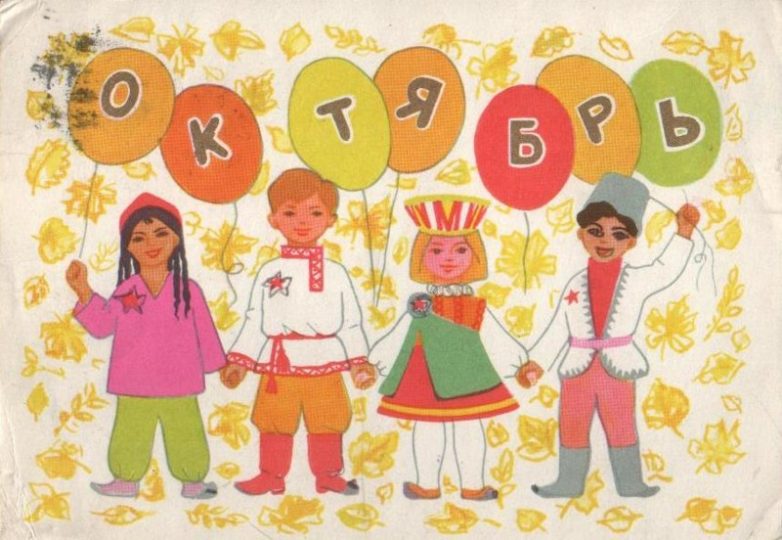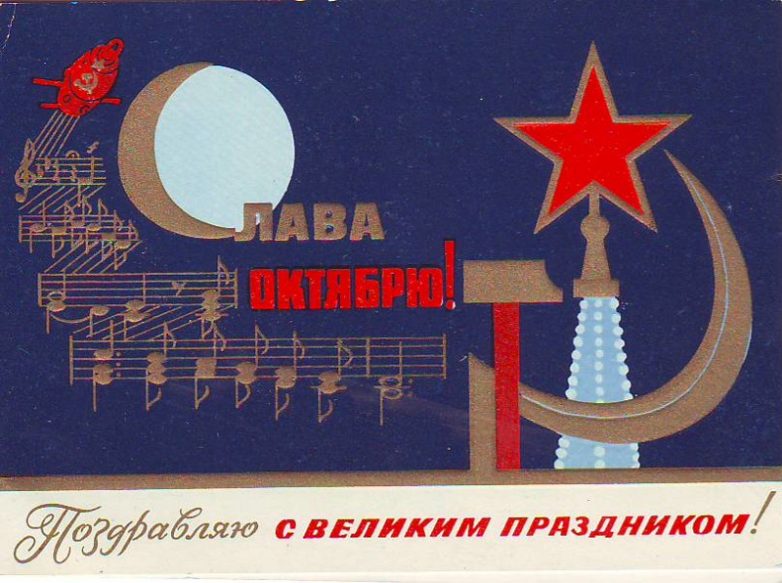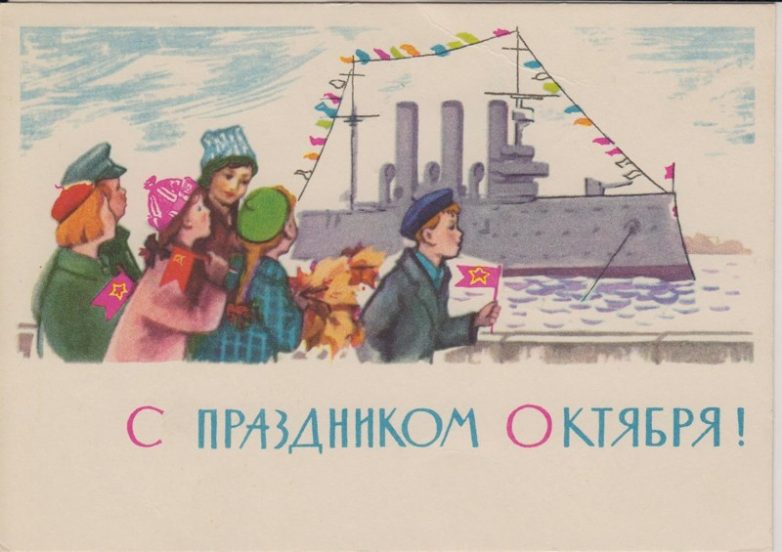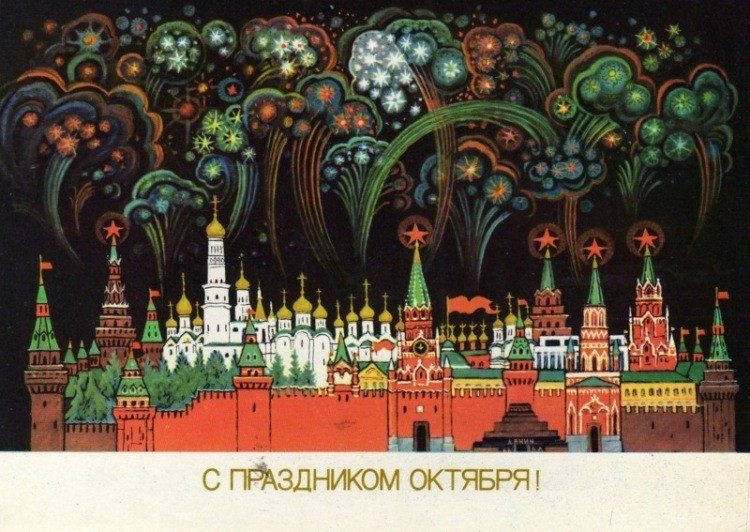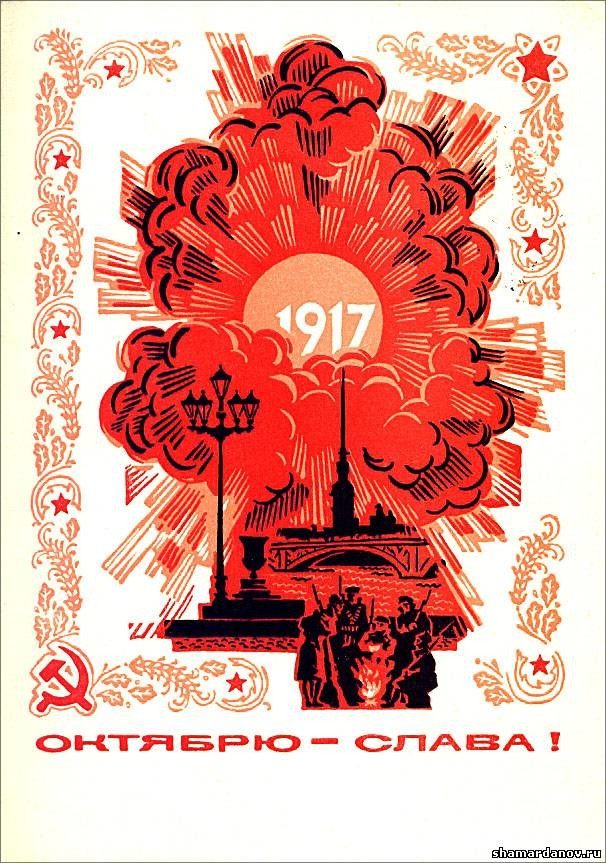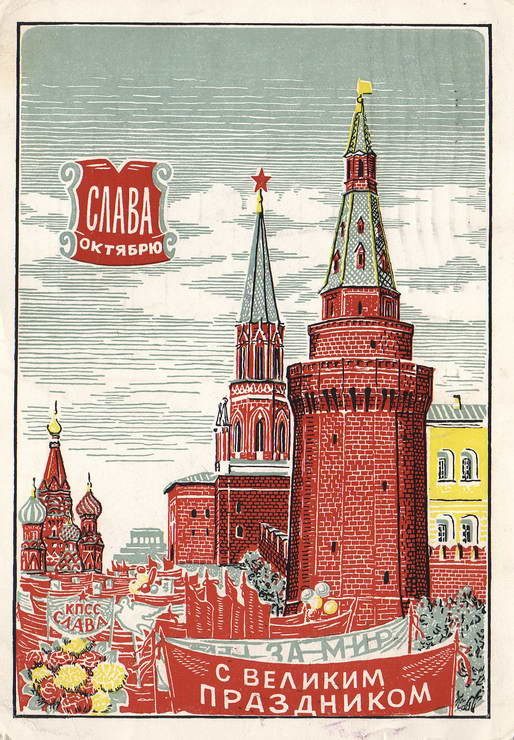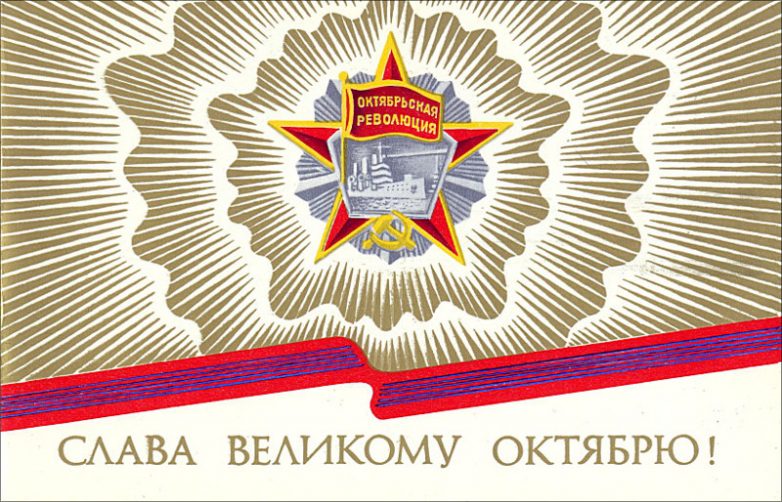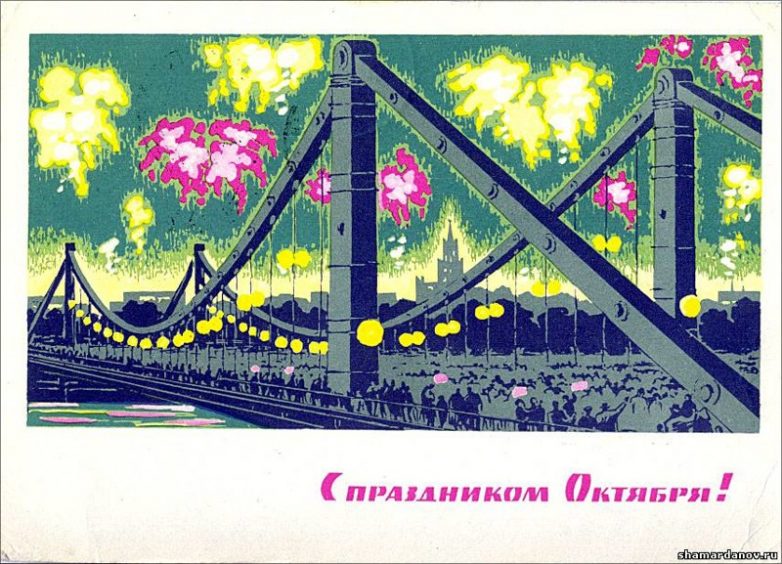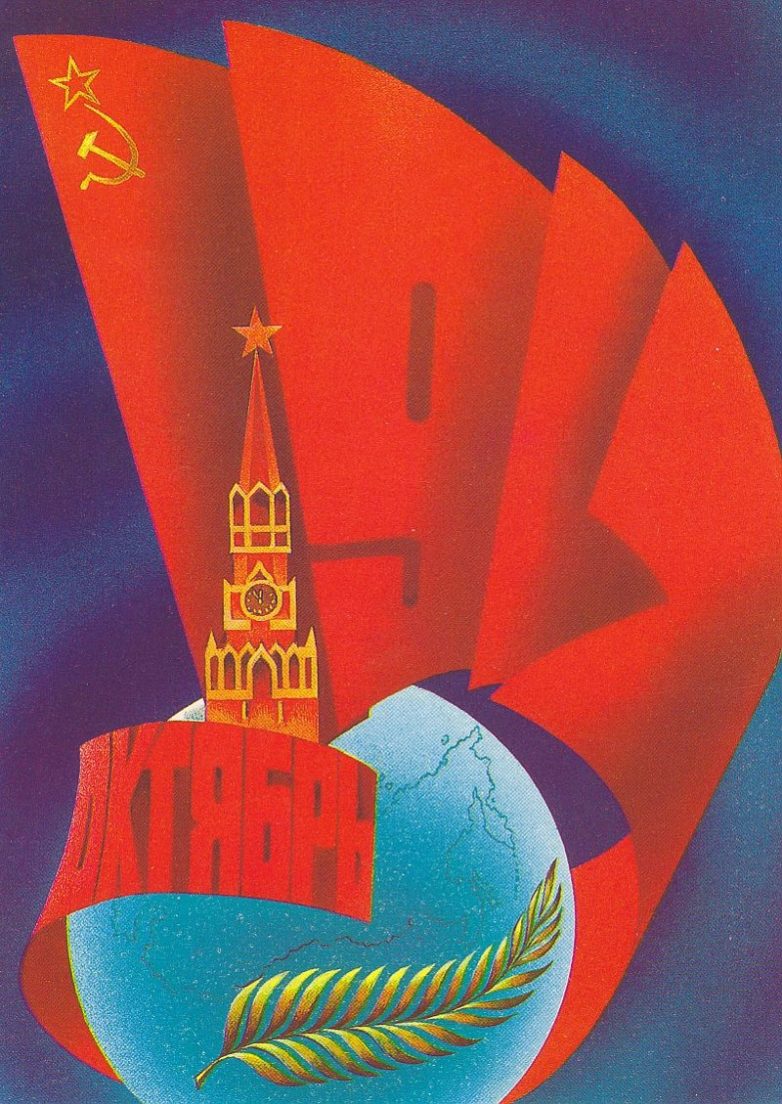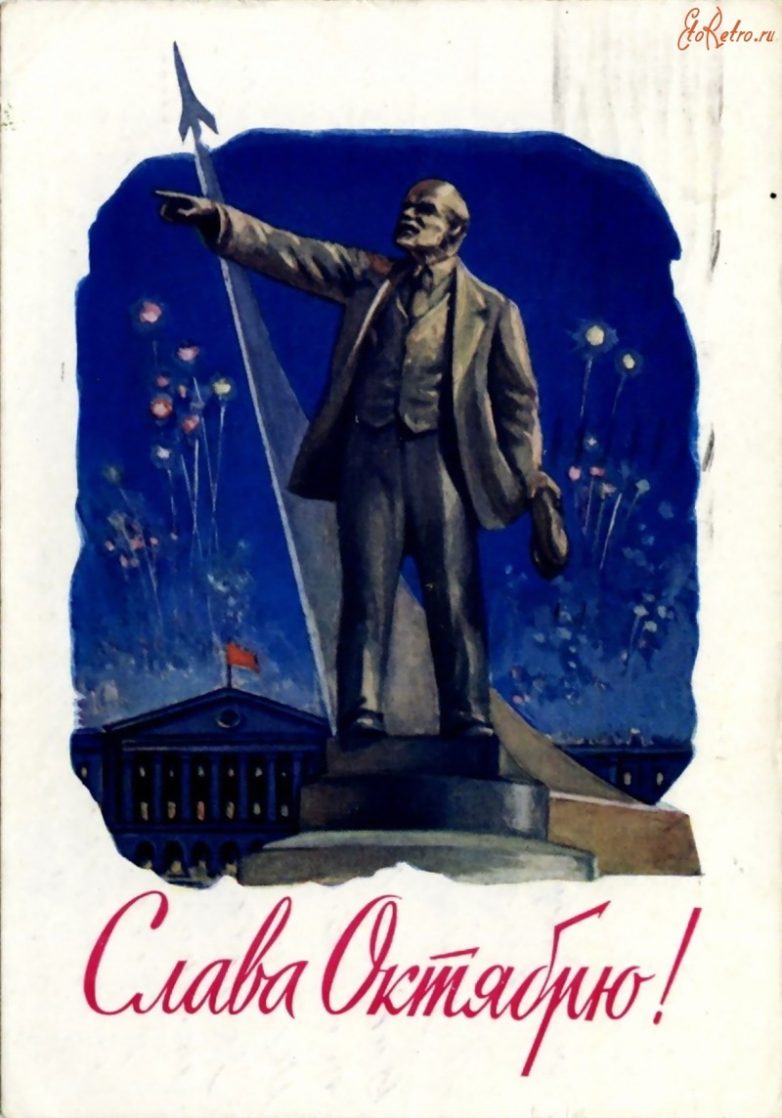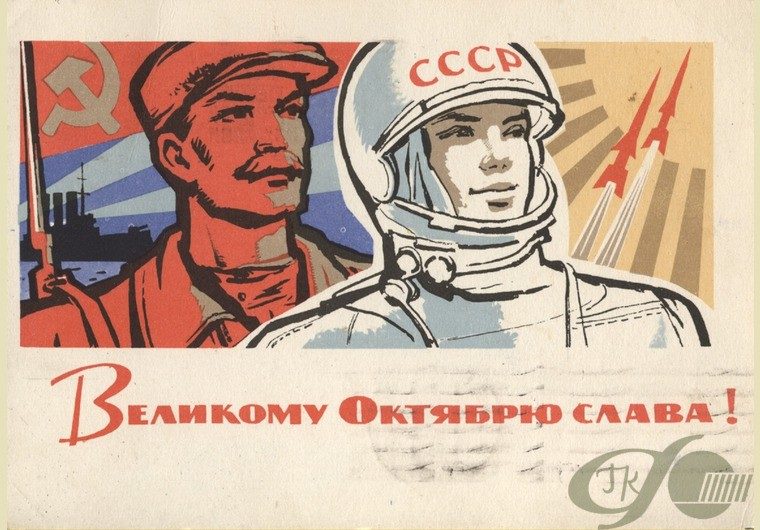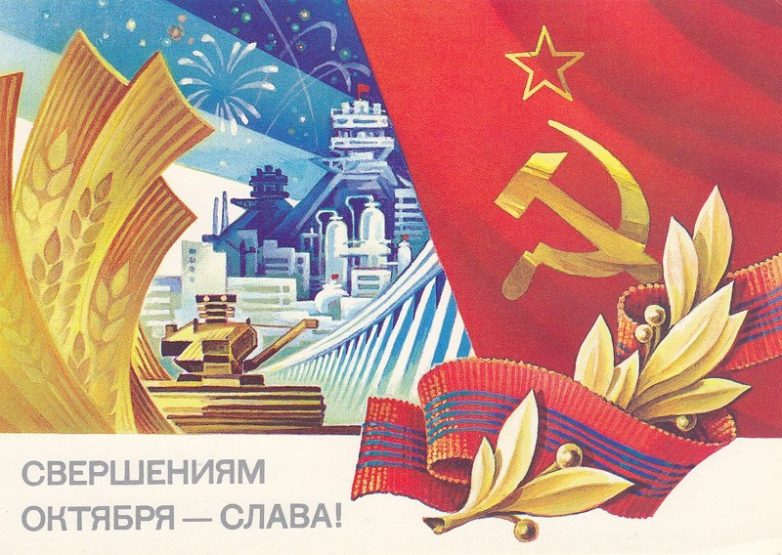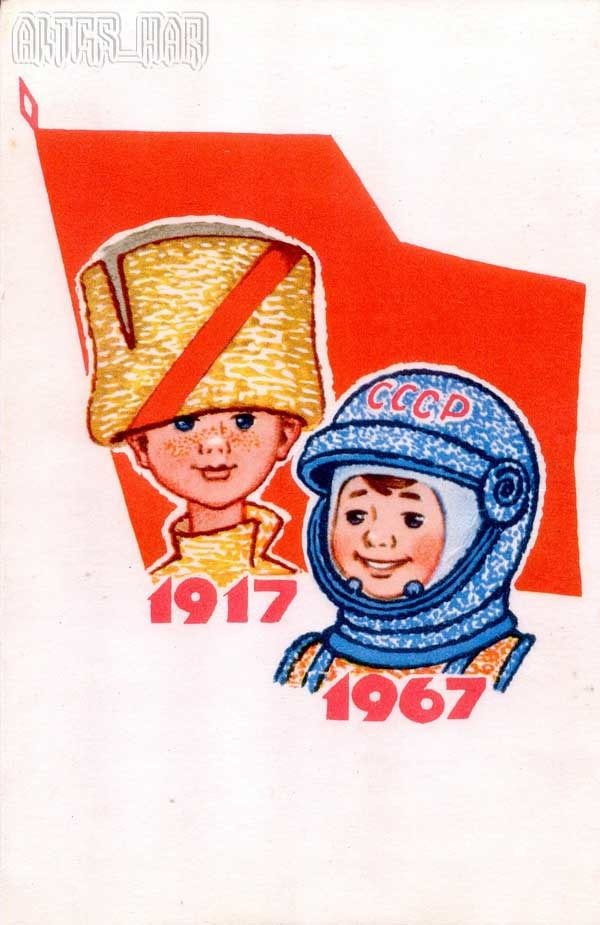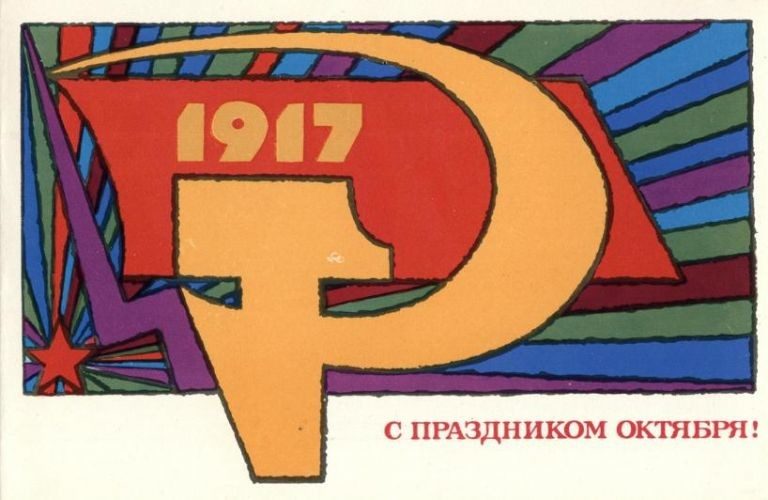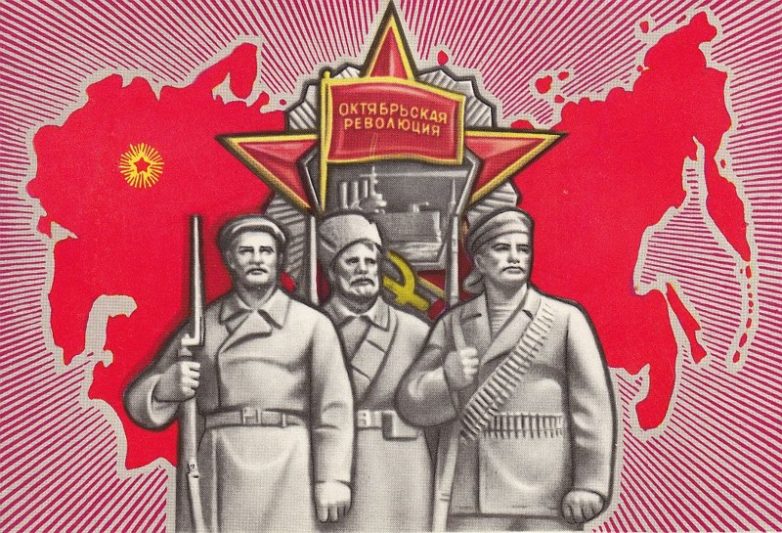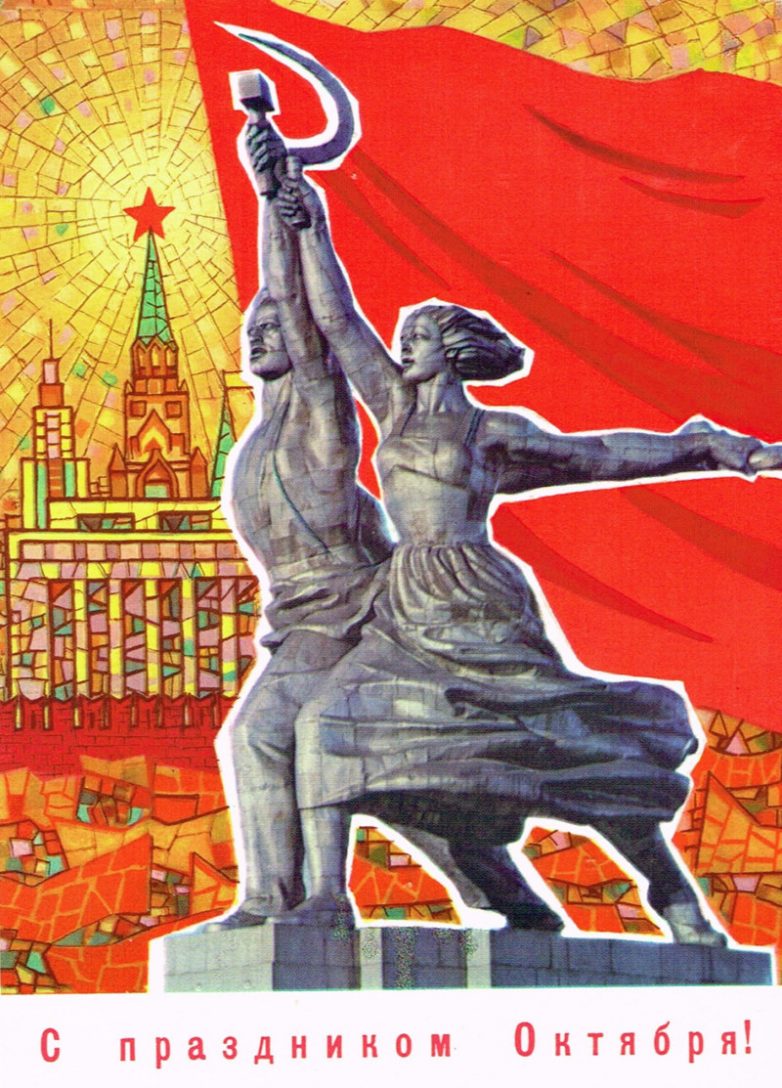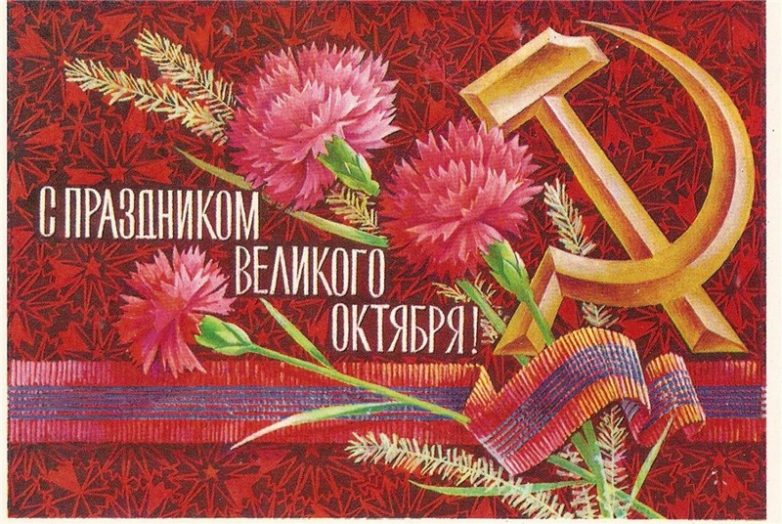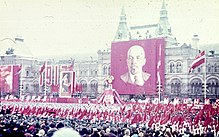Как проходили ноябрьские праздники в СССР
Автор:
05 ноября 2016 12:22
7 ноября советские люди отмечали, бесспорно, главный праздник Советского Союза — День Великой Октябрьской социалистической революции. Идеологическая основа была проста – праздновали день рождения нового государства рабочих и крестьян. И конечно, каждый школьник знал, почему День Октябрьской революции отмечается в начале ноября.
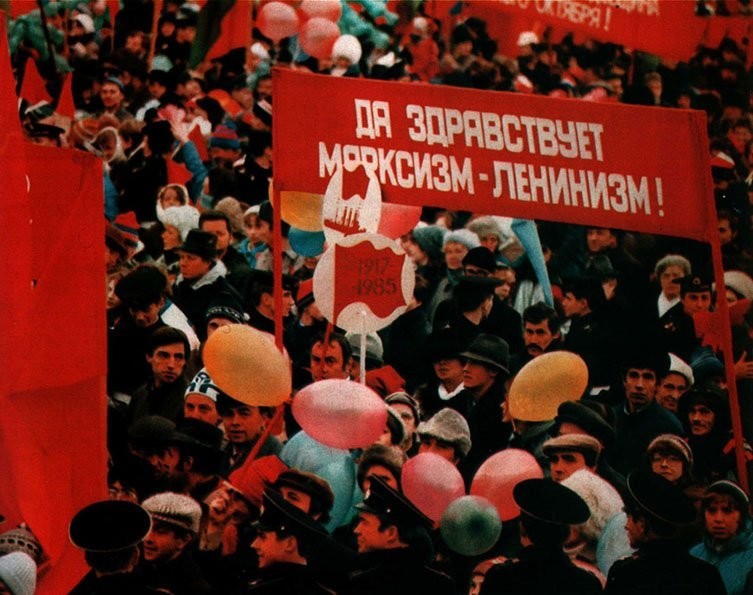
Источник:
Ежегодно 7 ноября парады шли по главным площадям городов страны. За ними следовали и демонстрации трудящихся. На трибуны выходили первые лица региона, принимавшие парад и приветствовавшие трудящихся, а также студентов и школьников, которые маршировали с флагами, плакатами и транспарантами в руках…
1940 год
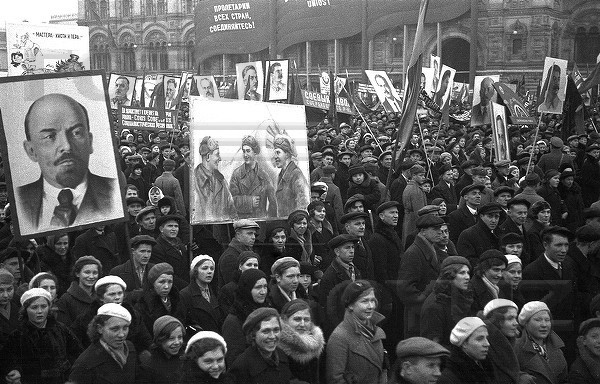
Источник:
1955 год, Воронеж
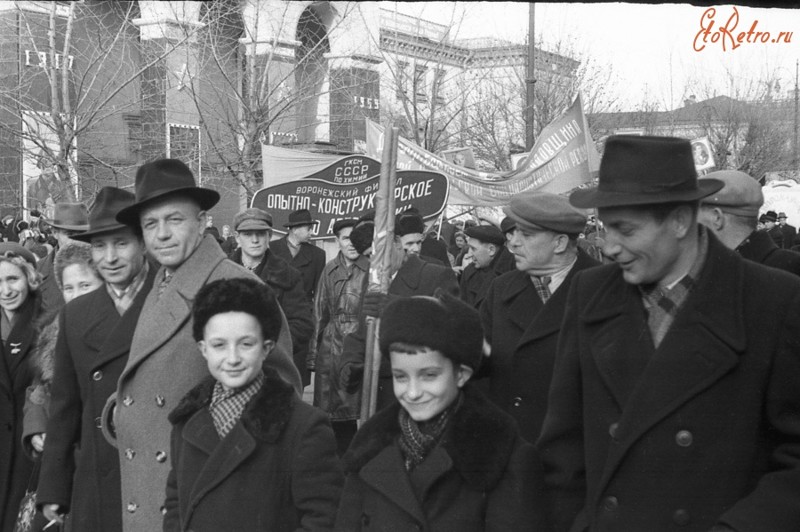
Источник:
1958 год
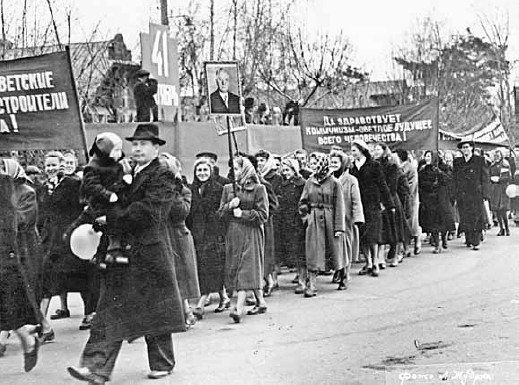
Источник:
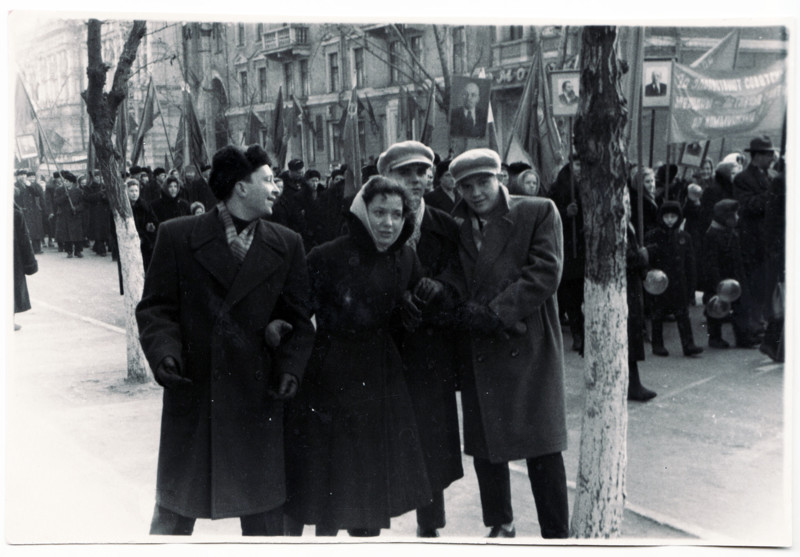
Источник:
1987 год
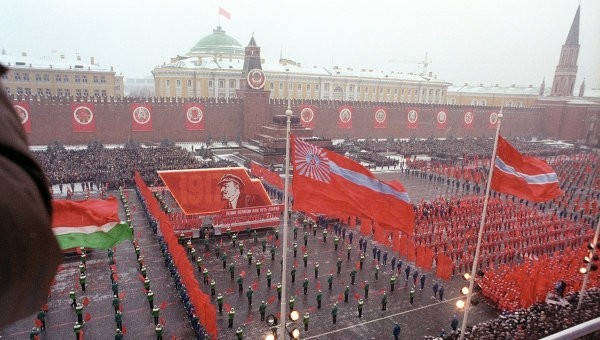
Источник:
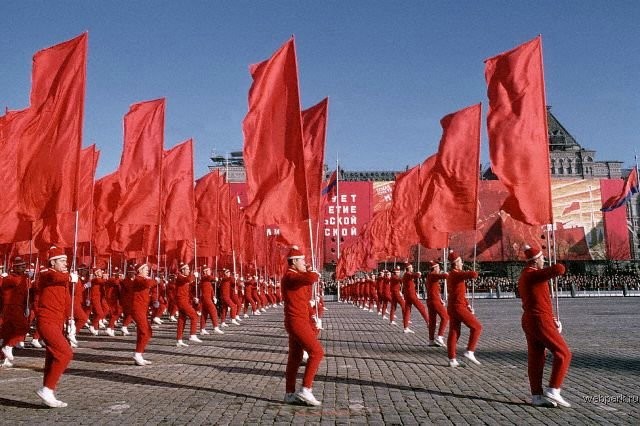
Источник:
День седьмого ноября –
Красный день календаря.
Посмотри в свое окно:
Все на улице красно!
1972 год, г. Кунгур
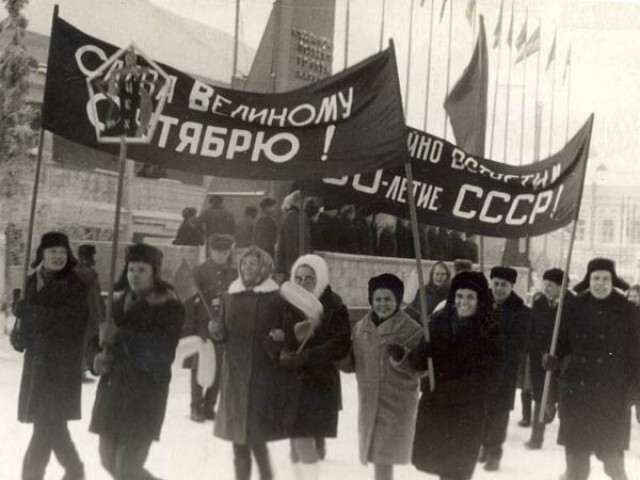
Источник:
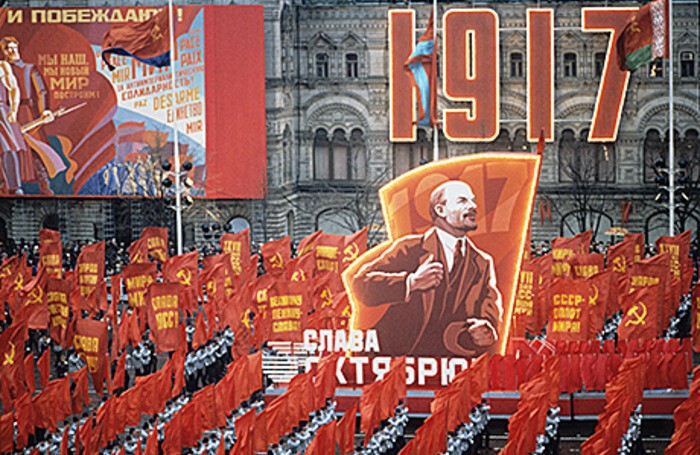
Источник:
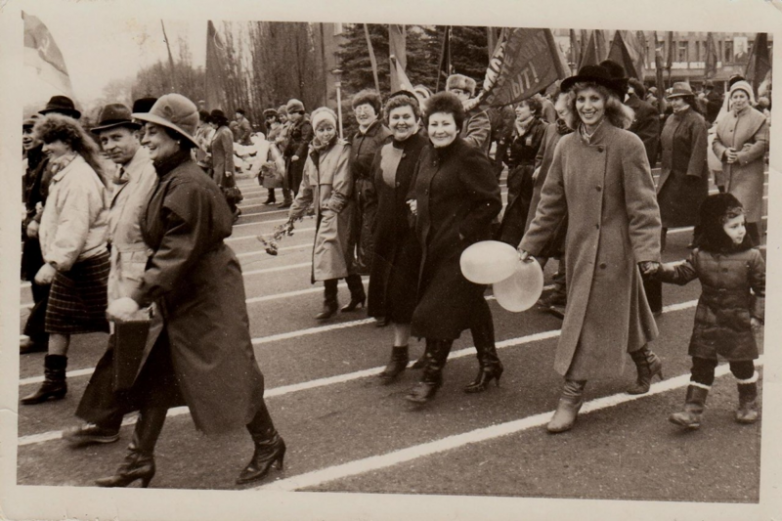
Источник:
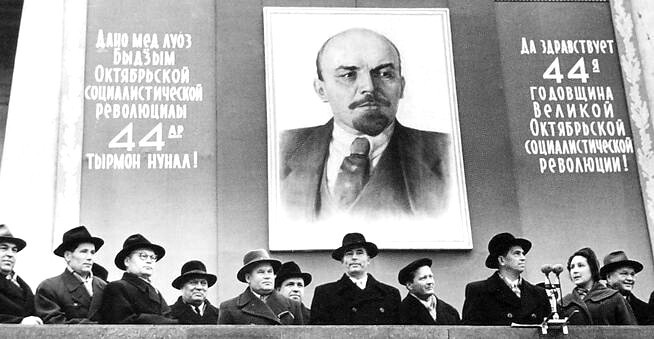
Источник:
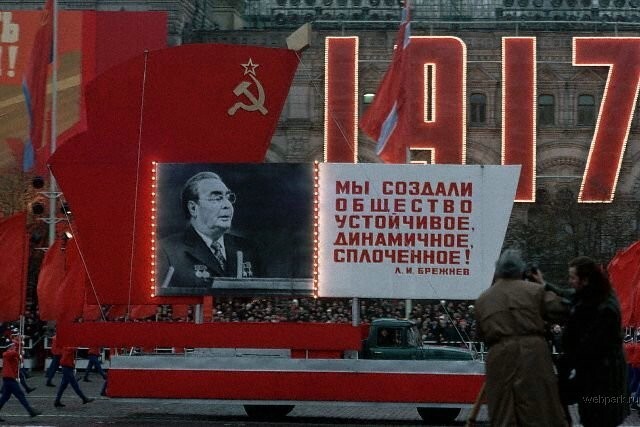
Источник:
Главные торжества проходили, конечно же, на Красной площади. Но свои парады и демонстрации были в каждом областном или краевом центре СССР.
Демонстрация 7 ноября 1977 года в Воронеже (серия фото из архива Эрхарда Ройтера, студента ВГУ в 1974-79 гг,)
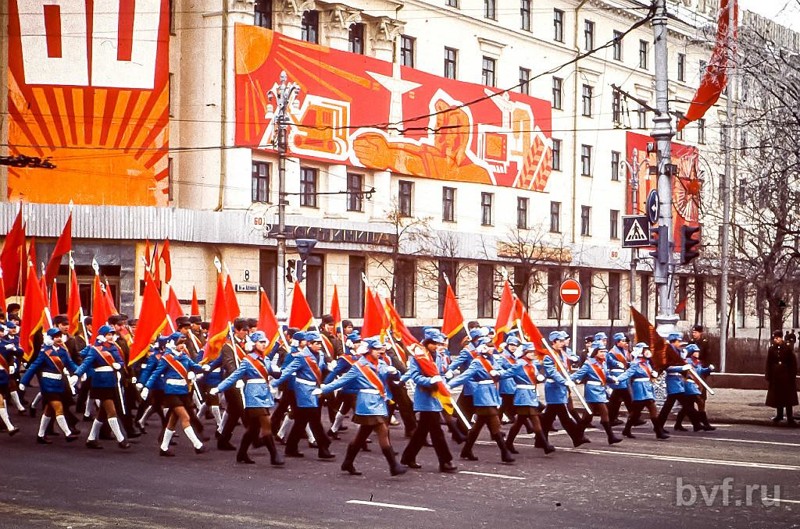
Источник:
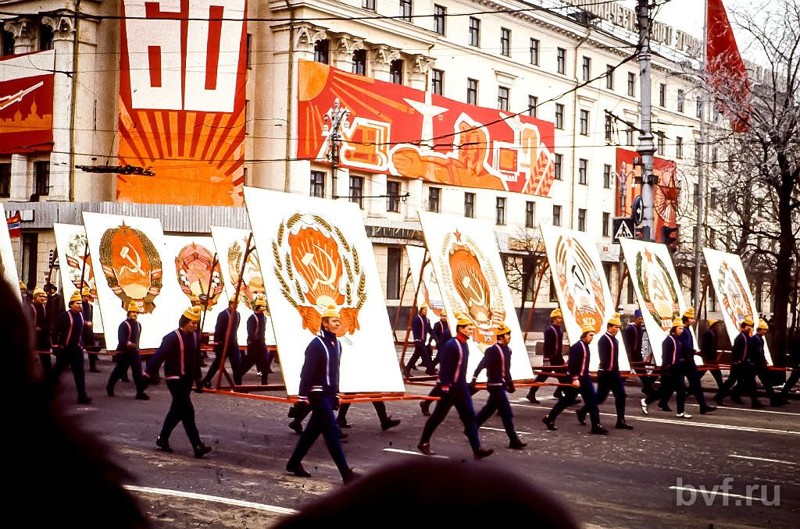
Источник:
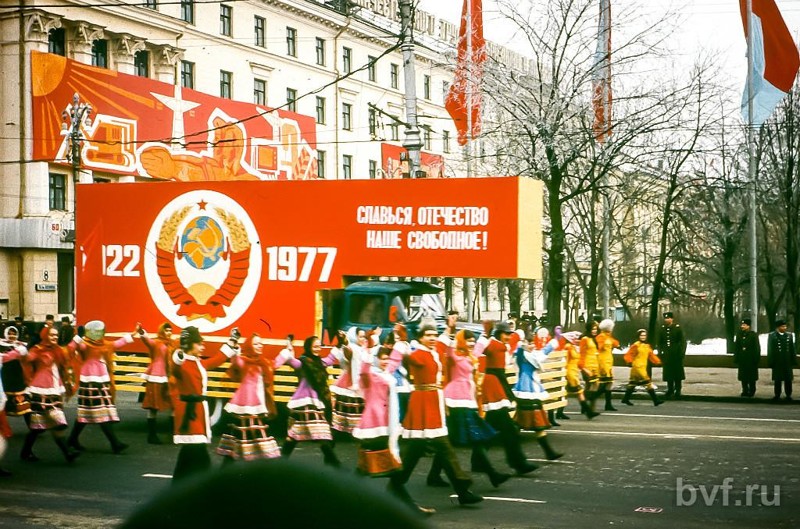
Источник:
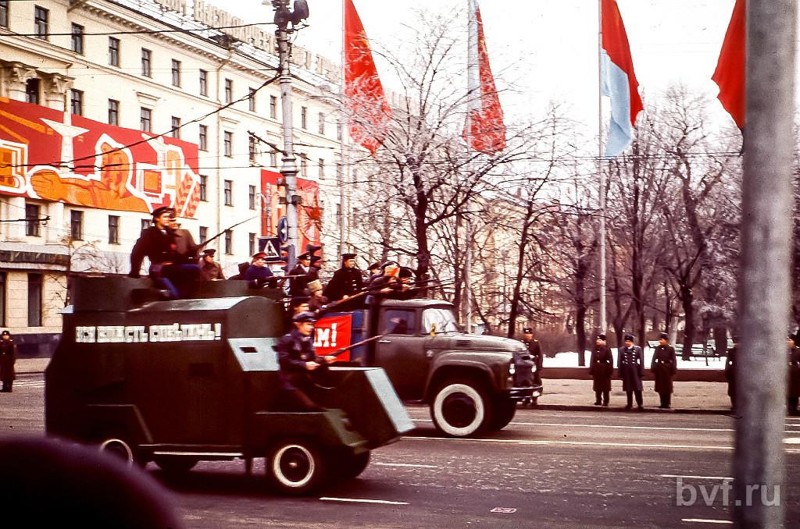
Источник:
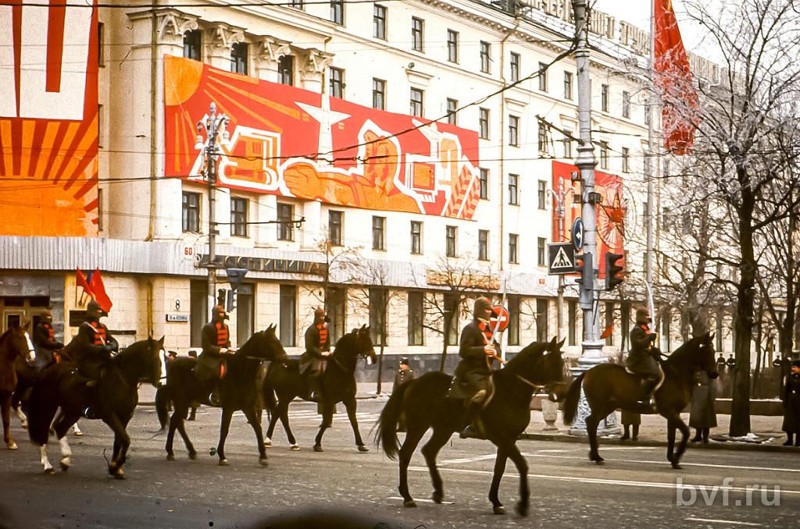
Источник:
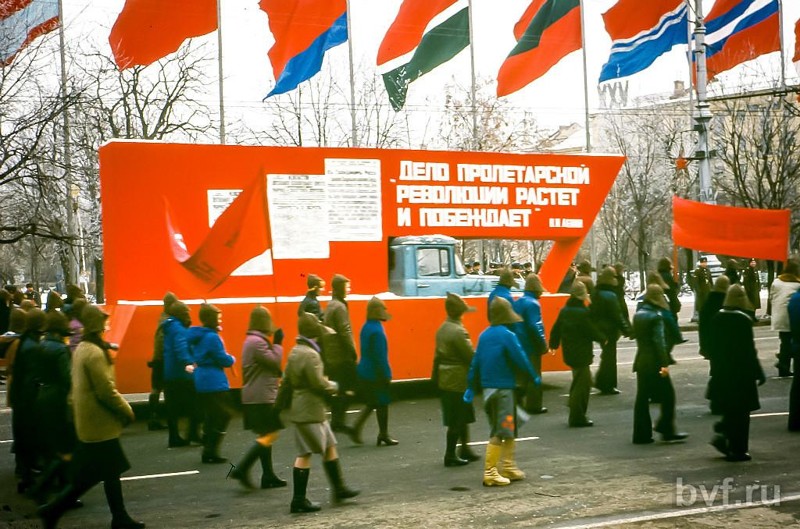
Источник:
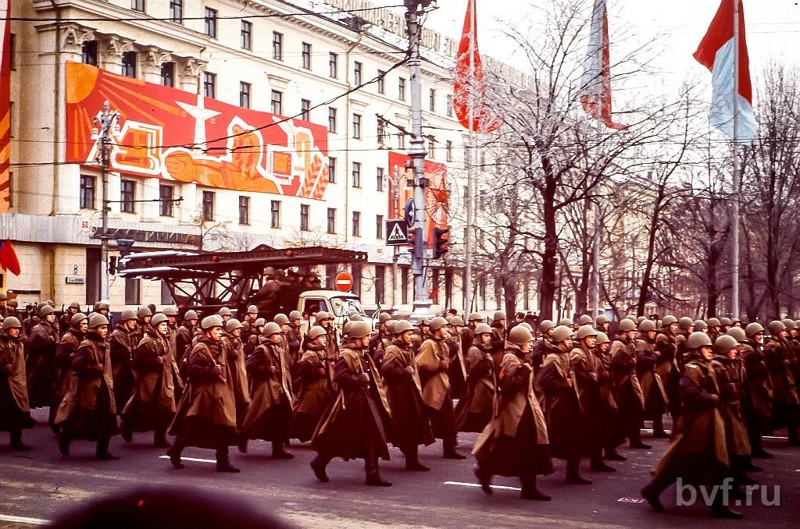
Источник:
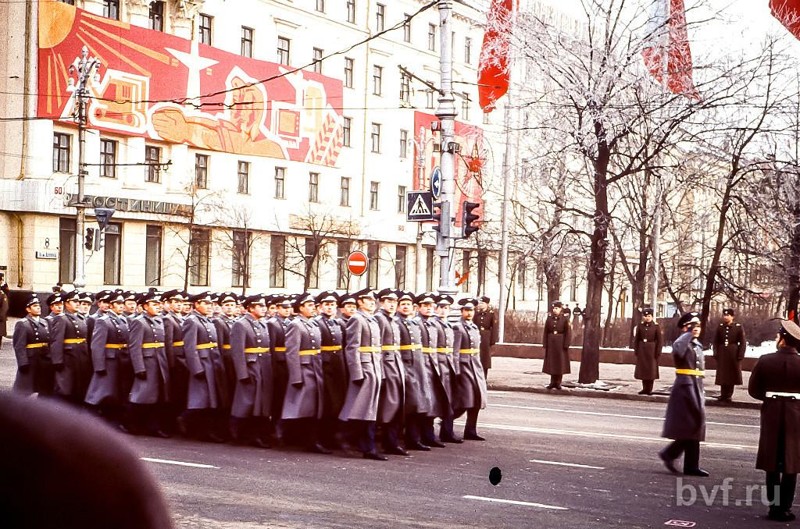
Источник:
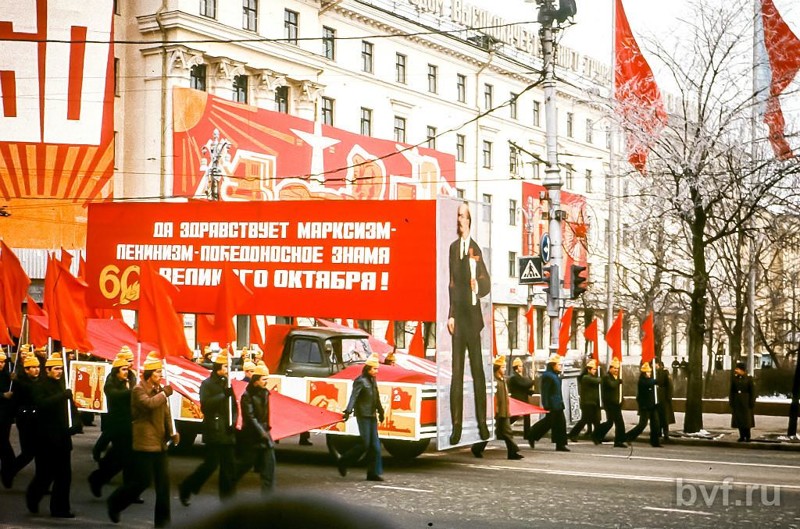
Источник:
1967 год, 50 лет советской власти
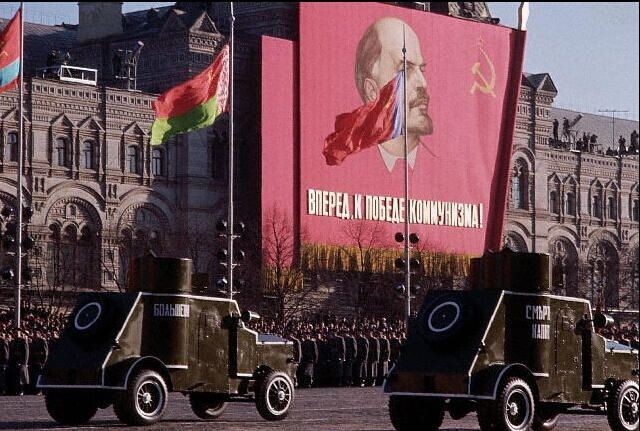
Источник:
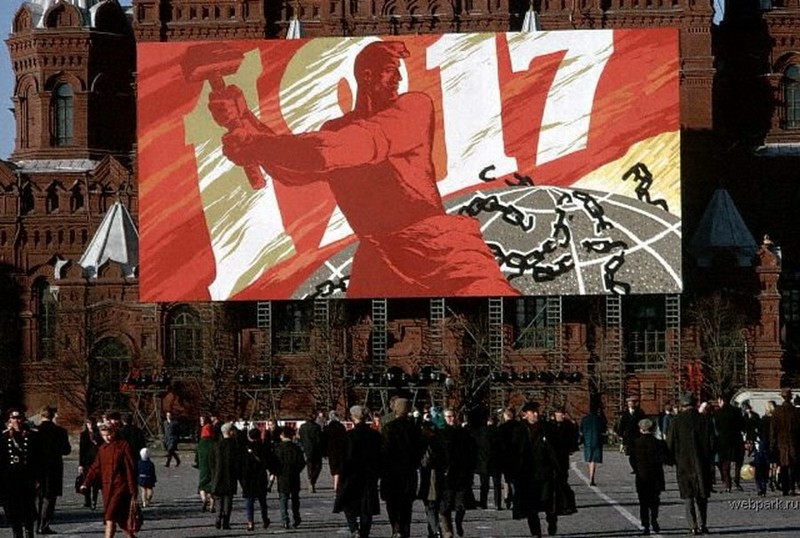
Источник:
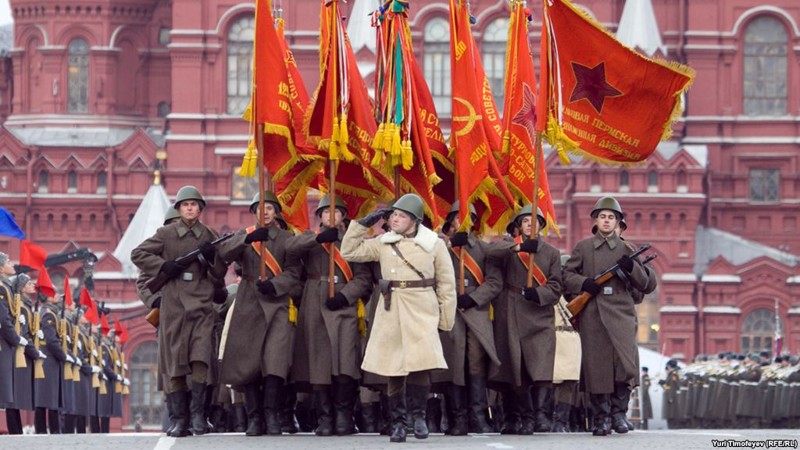
Источник:
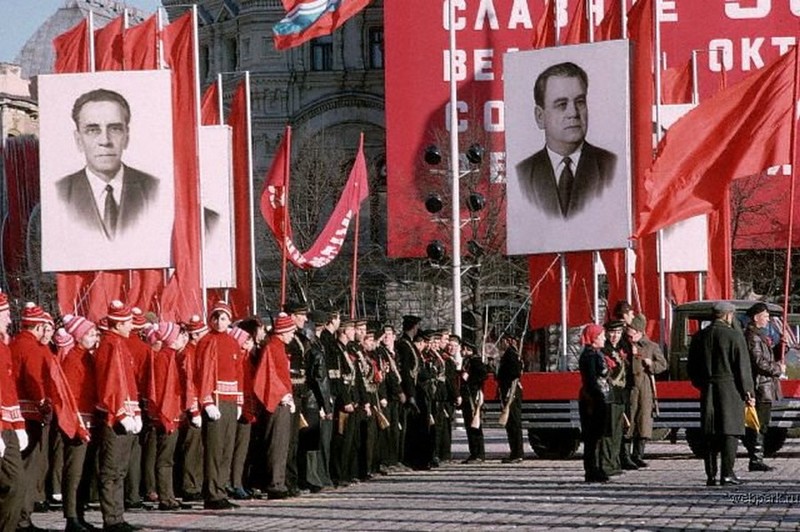
Источник:
1989 год
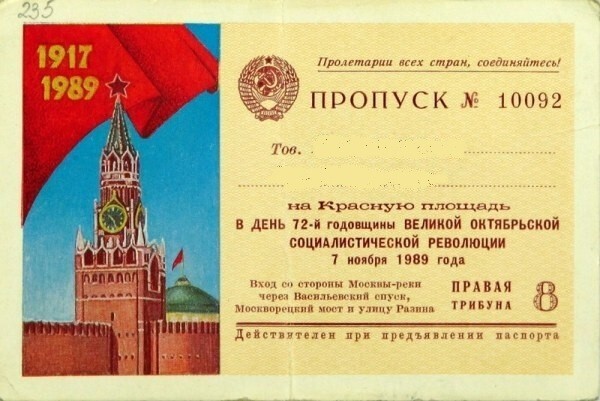
Источник:
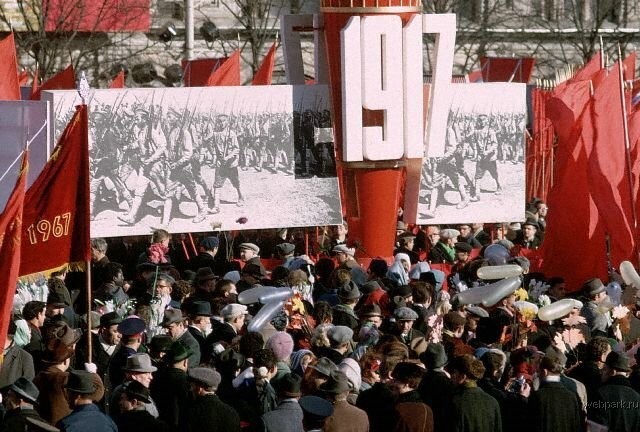
Источник:
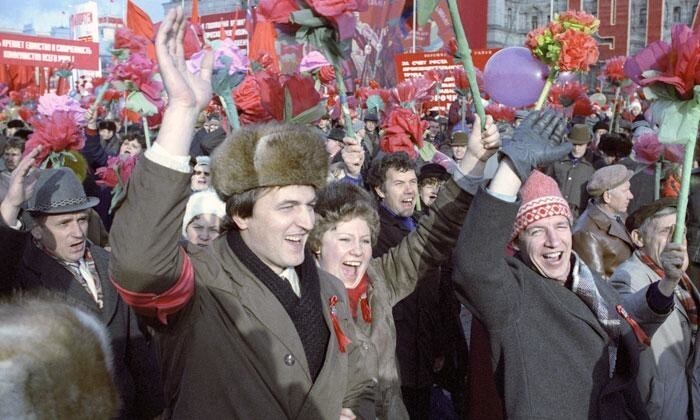
Источник:
Гражданам Страны Советов полагалось по этому поводу два выходных дня: 7 и 8 ноября: так постановил Президиум ЦИК СССР в 1927 году, в честь первой десятилетней годовщины революции.
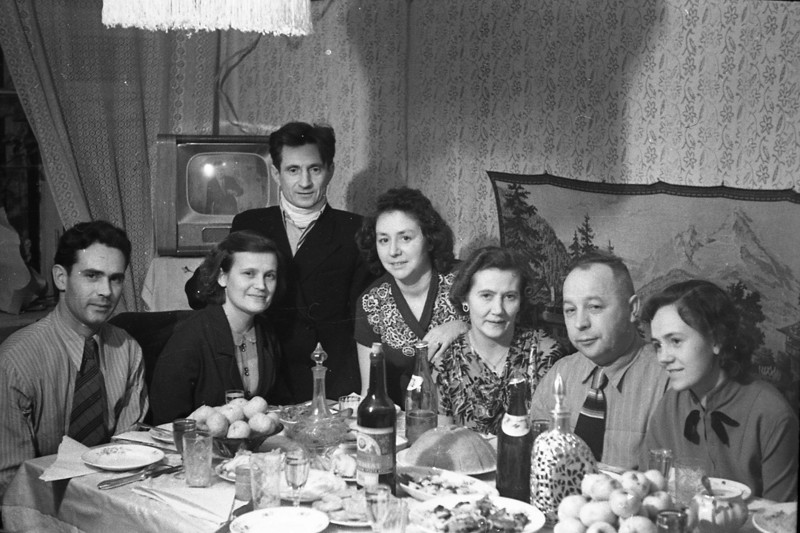
Источник:
После официальной части переходили к праздничному застолью. Каждая хозяйка приберегала что-то из дефицитного (в зависимости от года) к такому моменту: баночку икры или венгерского горошка, крабов или просто майонеза. Собирались гости, звучали тосты, а затем песни и танцы, насколько позволяла площадь квартир и комнат.

Источник:
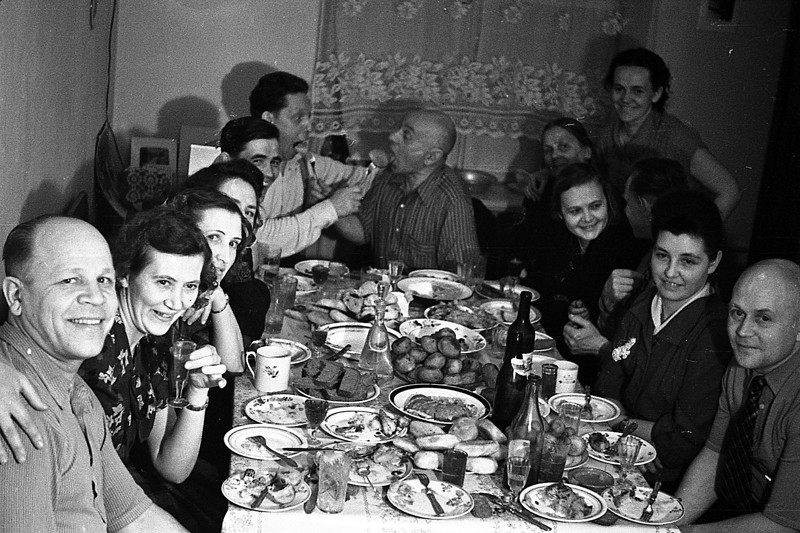
Источник:
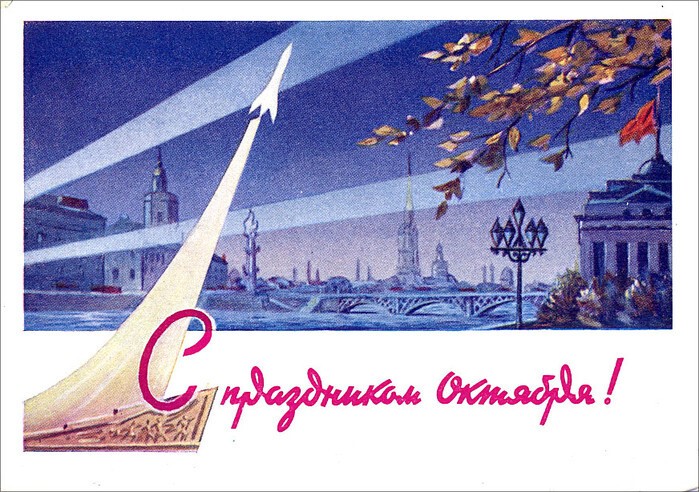
Источник:
Друзьям и родственникам было принято отправлять к 7 ноября поздравительные открытки. Среди выпускавшихся огромными тиражами почтовых картонок встречались и настоящие шедевры!
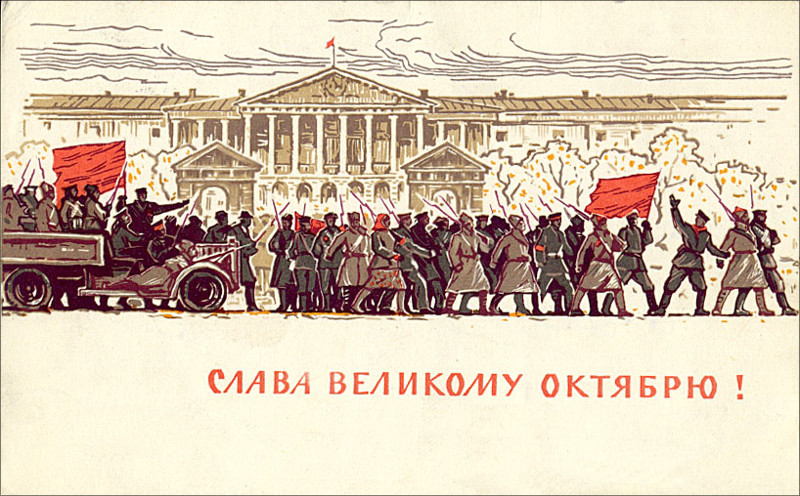
Источник:
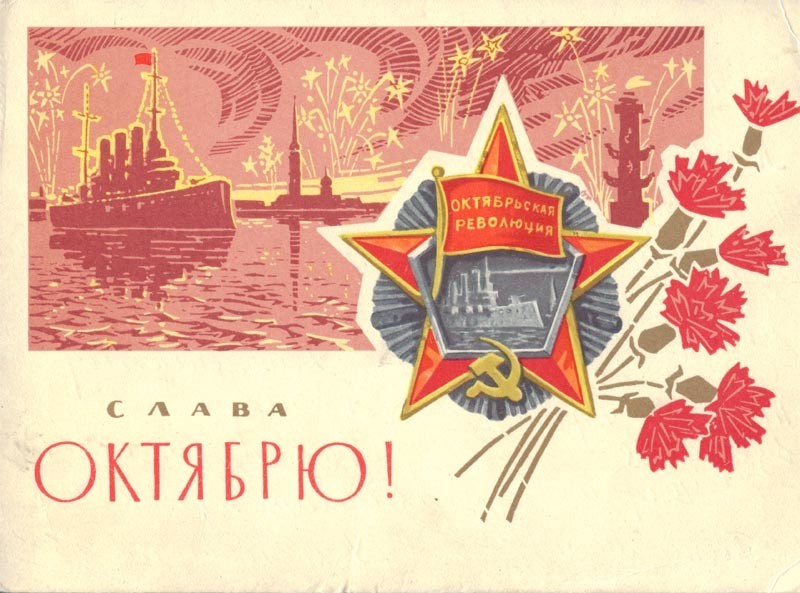
Источник:
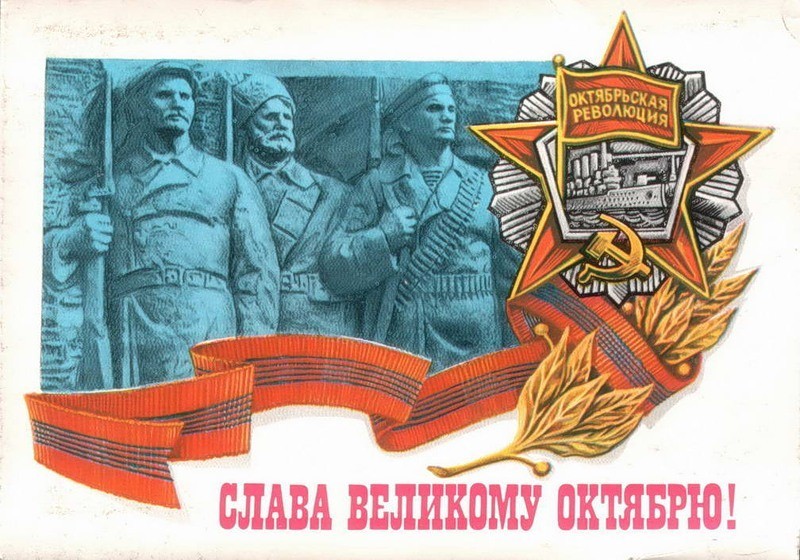
Источник:
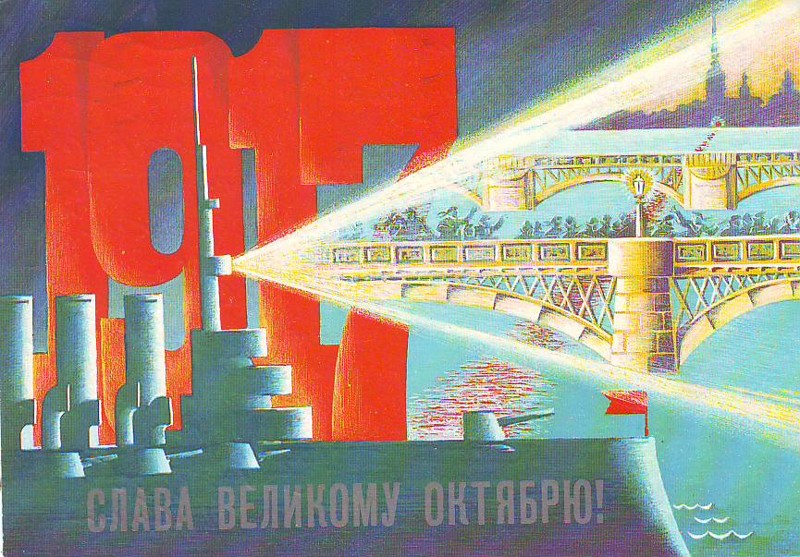
Источник:
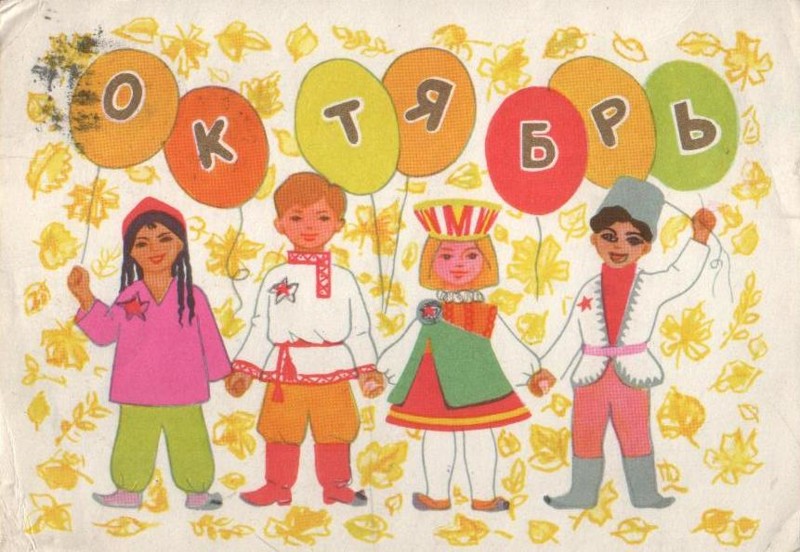
Источник:
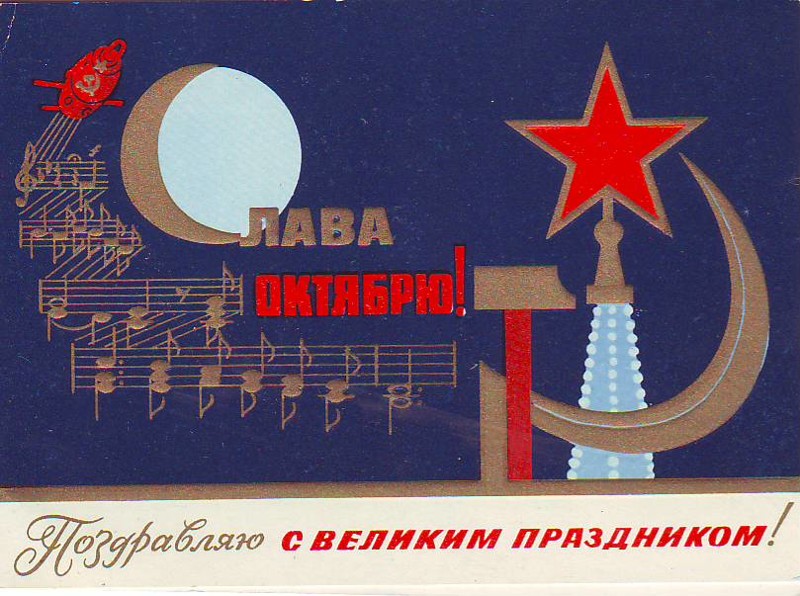
Источник:
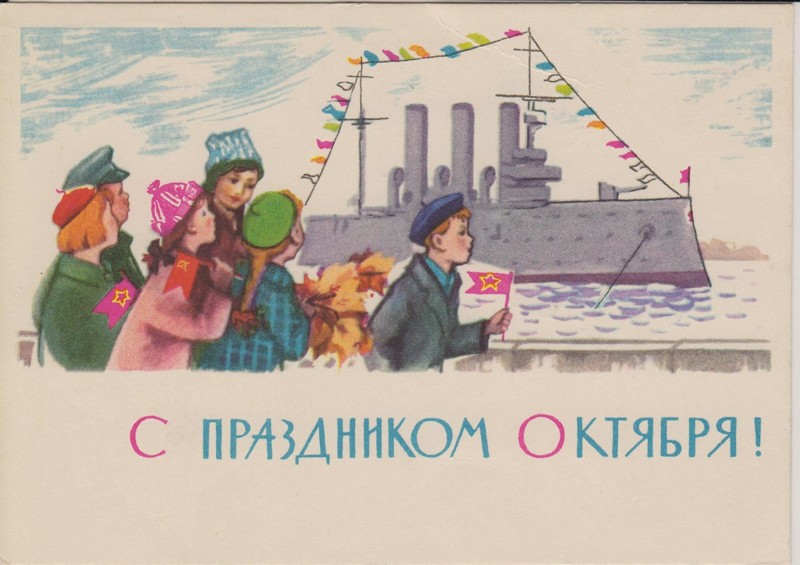
Источник:
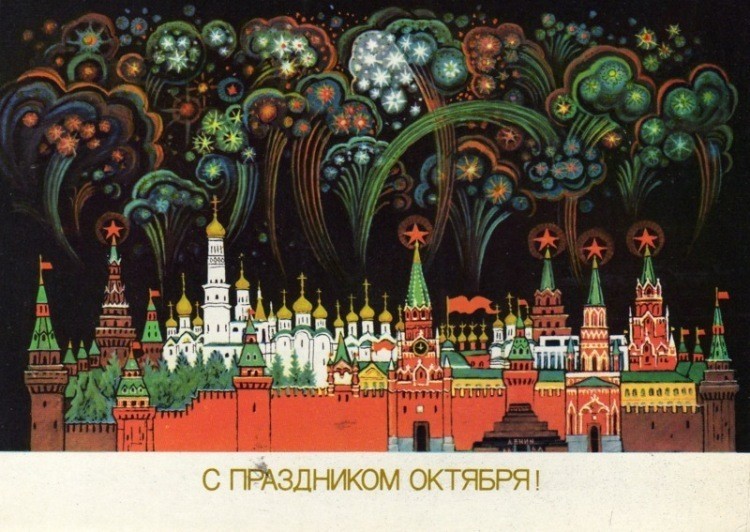
Источник:

Источник:
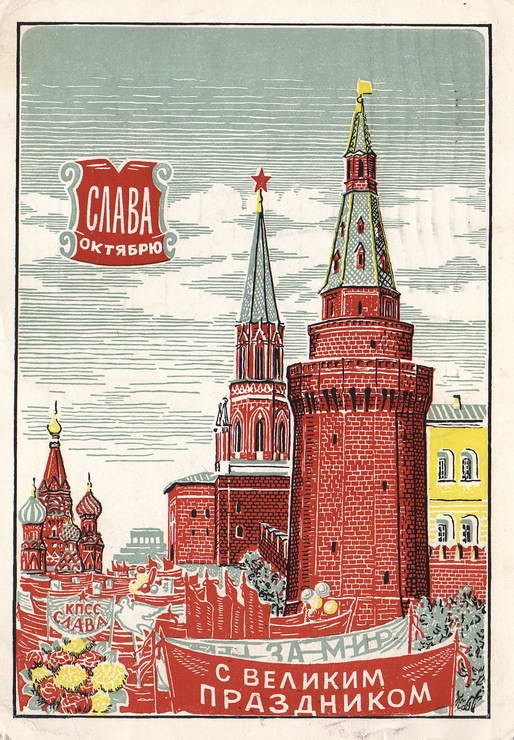
Источник:
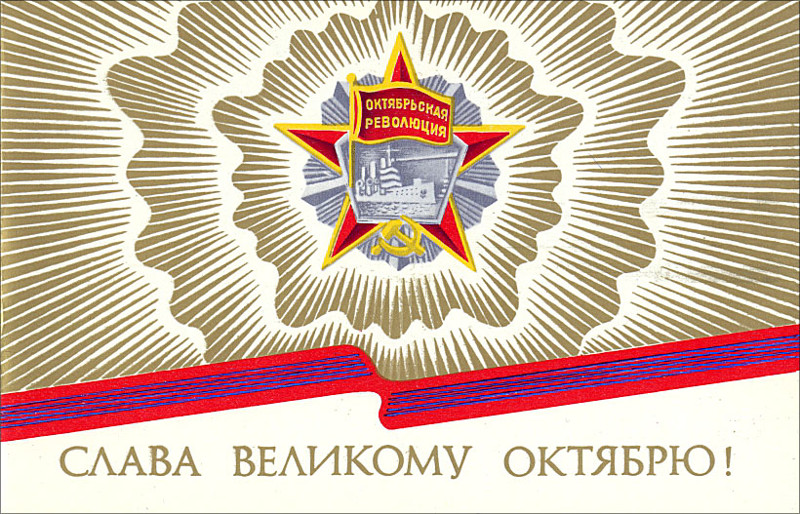
Источник:
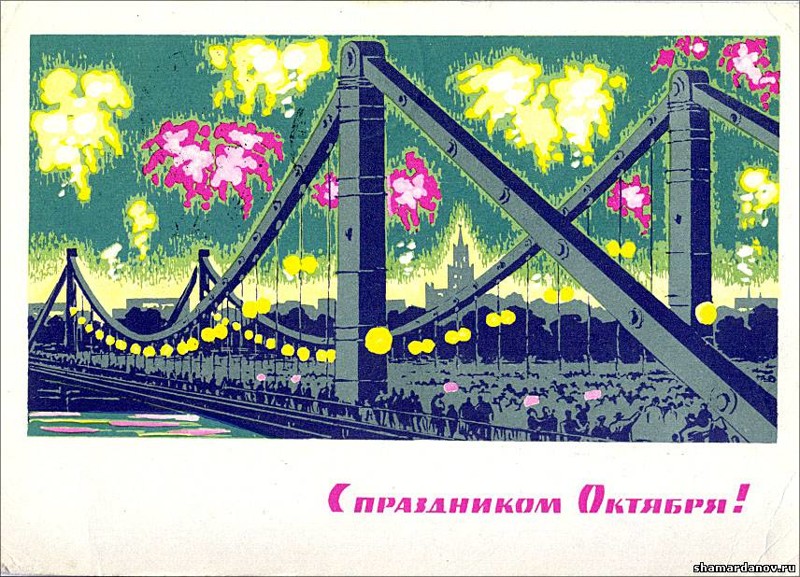
Источник:
Просто удивительно, насколько разные сюжеты для этих открыток удавалось найти и изобразить художникам! И надписи тоже радуют разнообразием…
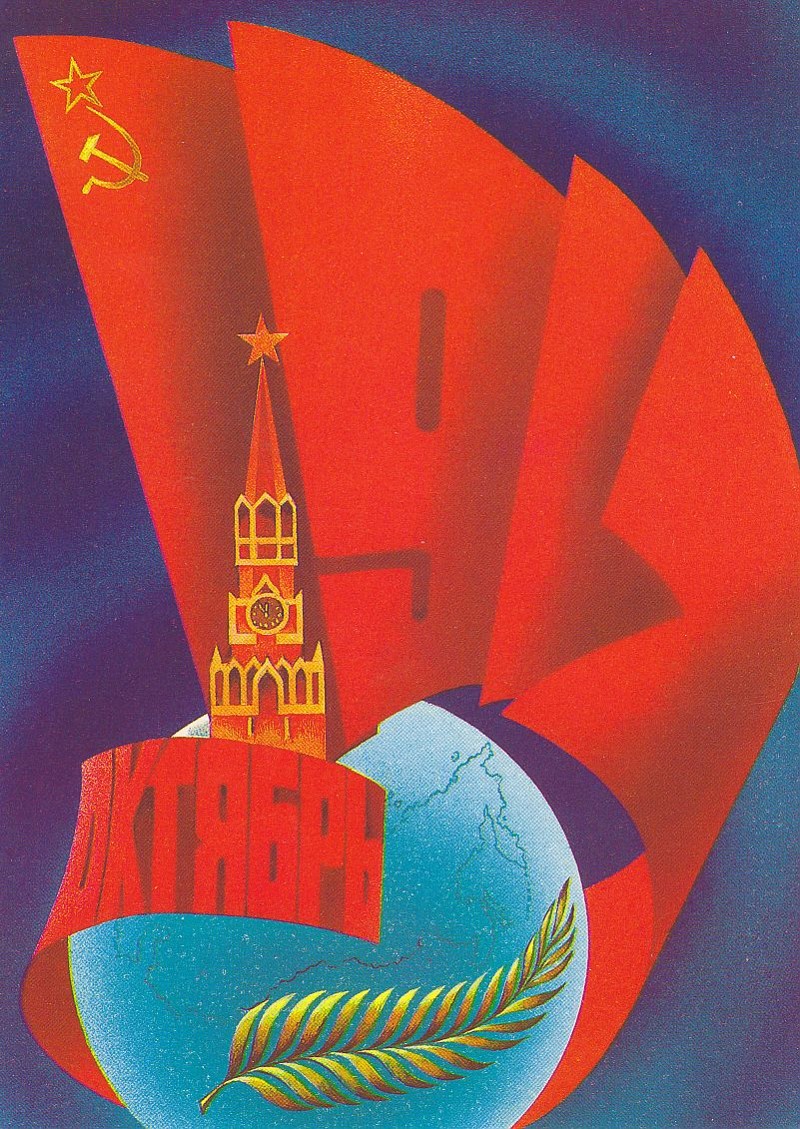
Источник:
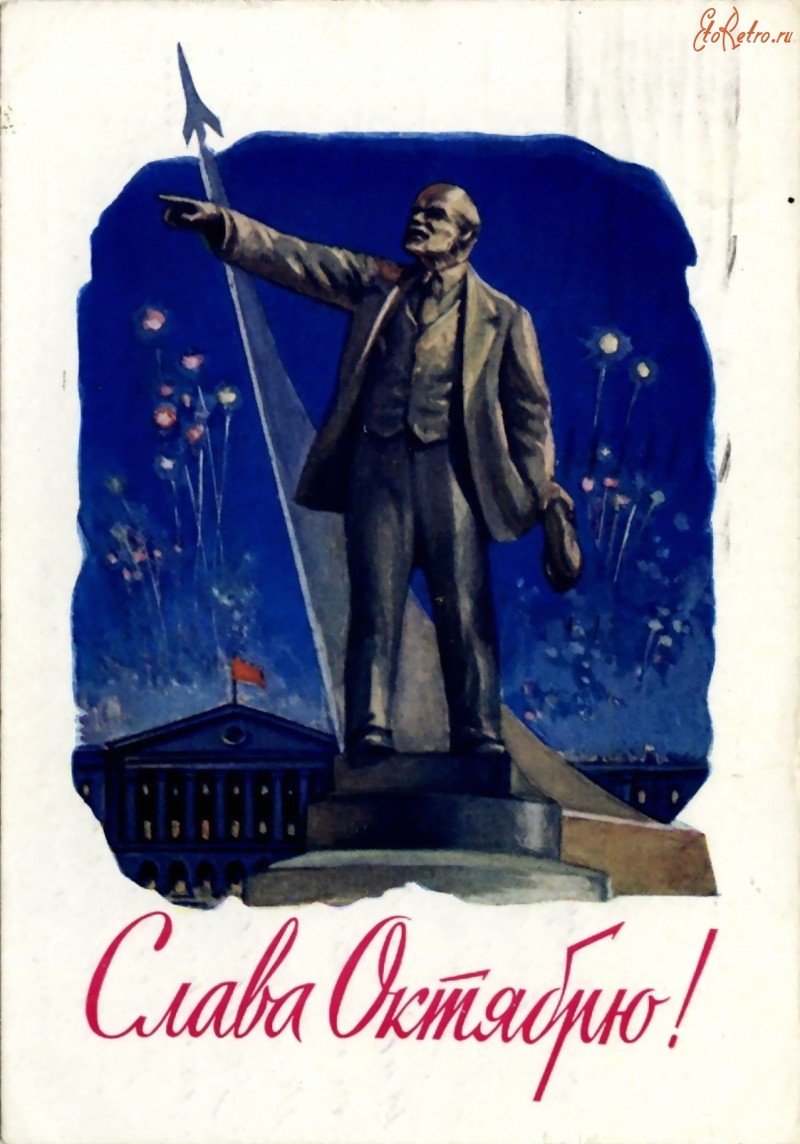
Источник:
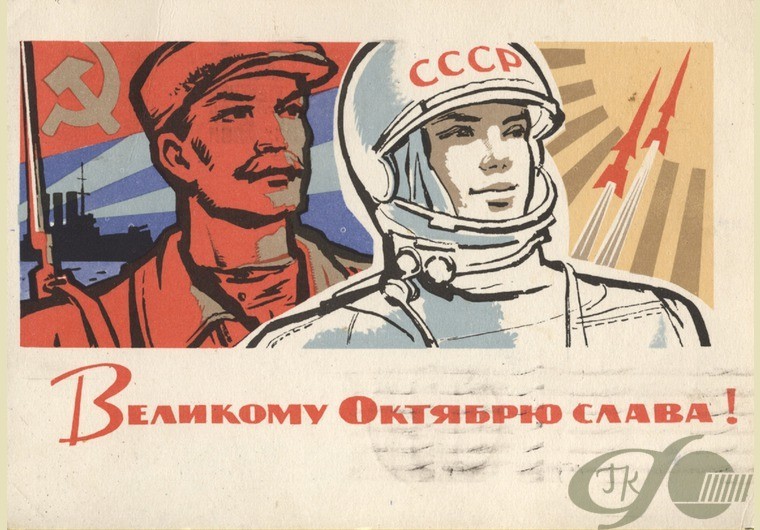
Источник:
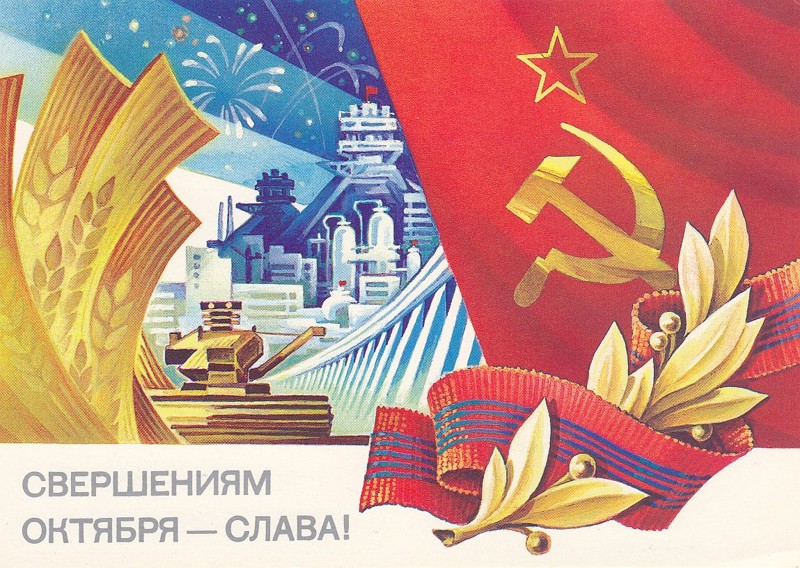
Источник:
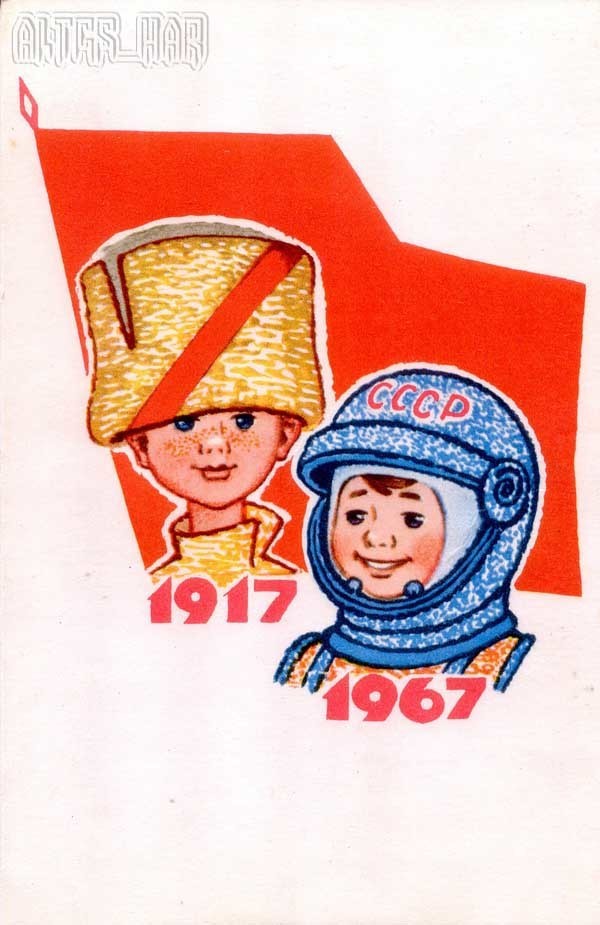
Источник:
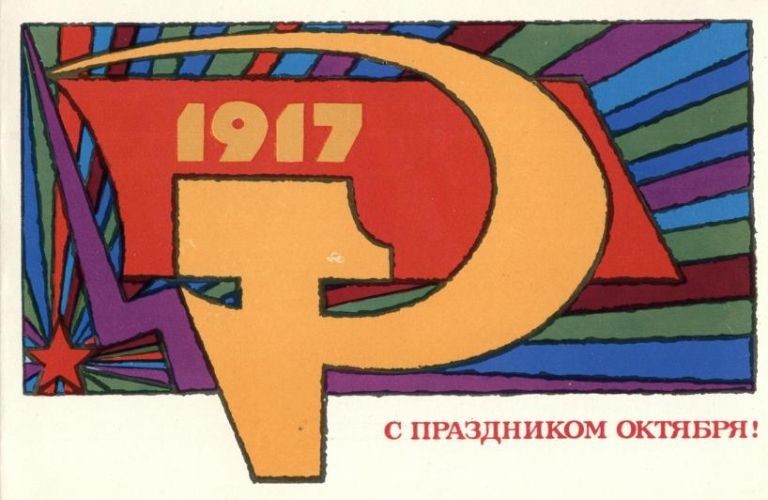
Источник:
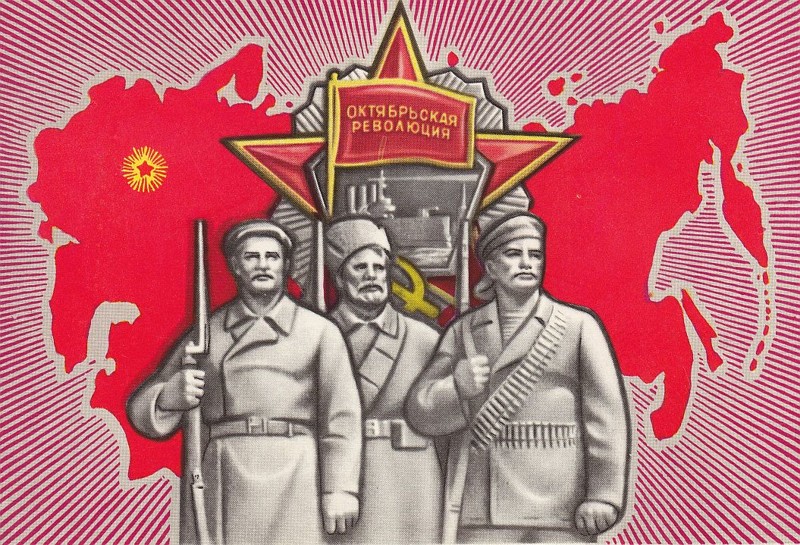
Источник:
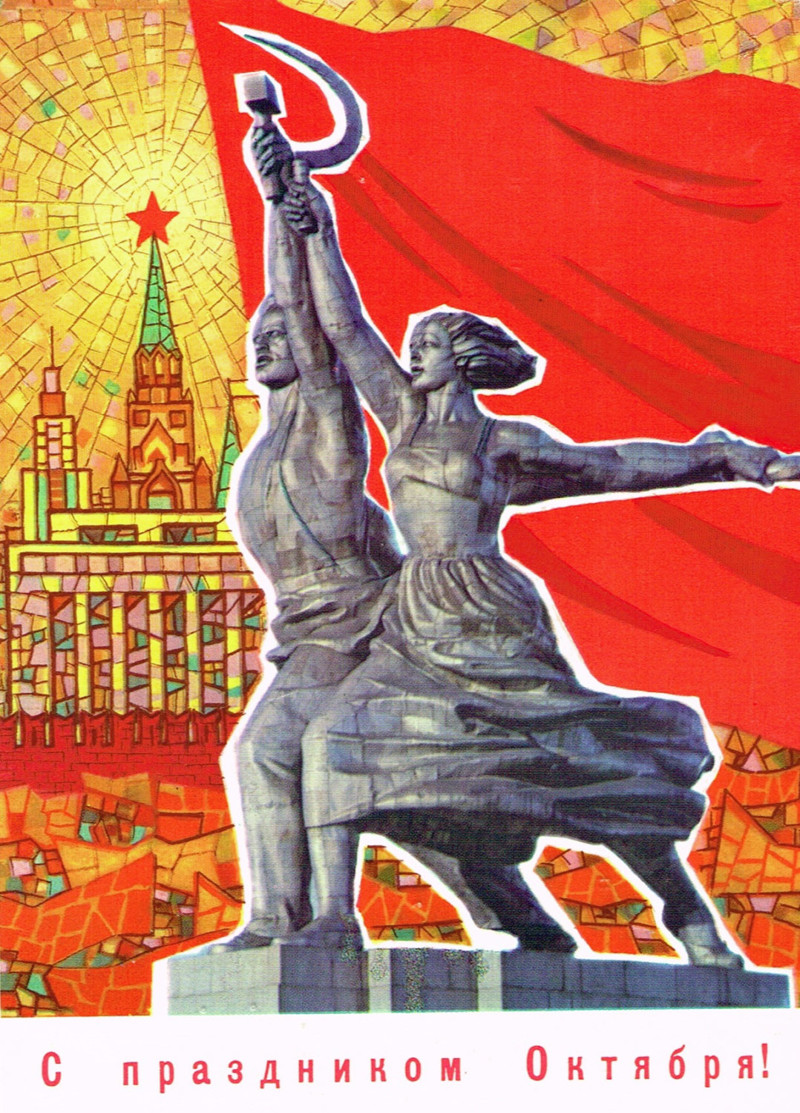
Источник:
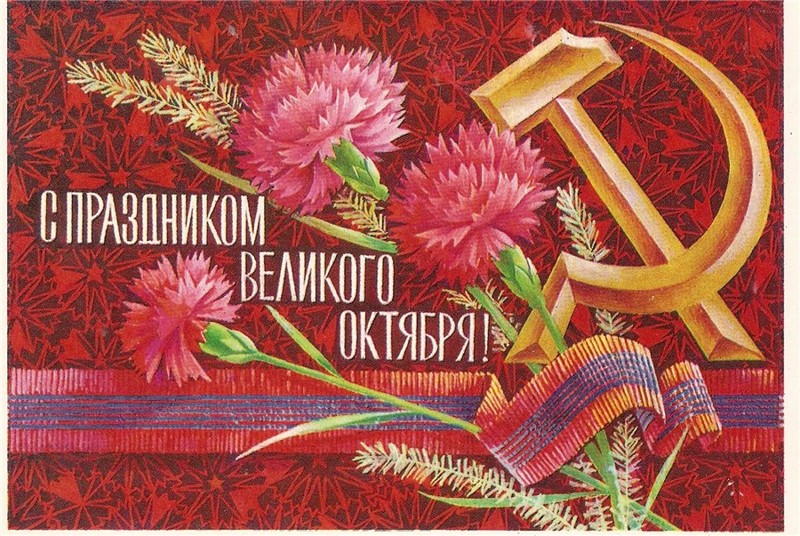
Источник:
Последний военный парад на Красной площади Москвы в ознаменование годовщины Октябрьской революции состоялся в 1990 году. С 1992 года в России 8 ноября стало рабочим днем. С 1996 года вместо Годовщины Великой Октябрьской социалистической революции решено отмечать День согласия и примирения. А в 2005 году в российском календаре появляется новый праздник — День народного единства, который отмечается 4 ноября, и 7-е тоже перестает быть выходным днем.
Источник:
Ссылки по теме:
Новости партнёров
реклама
7 ноября советские люди отмечали, бесспорно, главный праздник Советского Союза — День Великой Октябрьской социалистической революции. Идеологическая основа была проста – праздновали день рождения нового государства рабочих и крестьян. И конечно, каждый школьник знал, почему День Октябрьской революции отмечается в начале ноября.
Ежегодно 7 ноября парады шли по главным площадям городов страны. За ними следовали и демонстрации трудящихся. На трибуны выходили первые лица региона, принимавшие парад и приветствовавшие трудящихся, а также студентов и школьников, которые маршировали с флагами, плакатами и транспарантами в руках…
1940 год
1955 год, Воронеж
1958 год
1987 год
День седьмого ноября –
Красный день календаря.
Посмотри в свое окно:
Все на улице красно!
1972 год, г. Кунгур
Главные торжества проходили, конечно же, на Красной площади. Но свои парады и демонстрации были в каждом областном или краевом центре СССР.
Демонстрация 7 ноября 1977 года в Воронеже (серия фото из архива Эрхарда Ройтера, студента ВГУ в 1974-79 гг,)
1967 год, 50 лет советской власти
1989 год
Гражданам Страны Советов полагалось по этому поводу два выходных дня: 7 и 8 ноября: так постановил Президиум ЦИК СССР в 1927 году, в честь первой десятилетней годовщины революции.
После официальной части переходили к праздничному застолью. Каждая хозяйка приберегала что-то из дефицитного (в зависимости от года) к такому моменту: баночку икры или венгерского горошка, крабов или просто майонеза. Собирались гости, звучали тосты, а затем песни и танцы, насколько позволяла площадь квартир и комнат.
Друзьям и родственникам было принято отправлять к 7 ноября поздравительные открытки. Среди выпускавшихся огромными тиражами почтовых картонок встречались и настоящие шедевры!
Просто удивительно, насколько разные сюжеты для этих открыток удавалось найти и изобразить художникам! И надписи тоже радуют разнообразием…
Последний военный парад на Красной площади Москвы в ознаменование годовщины Октябрьской революции состоялся в 1990 году. С 1992 года в России 8 ноября стало рабочим днем. С 1996 года вместо Годовщины Великой Октябрьской социалистической революции решено отмечать День согласия и примирения. А в 2005 году в российском календаре появляется новый праздник — День народного единства, который отмечается 4 ноября, и 7-е тоже перестает быть выходным днем.
Богослужения
Тропари, кондаки, молитвы и величания
Мученикам Маркиану и Мартирию
Тропарь мученикам Маркиану и Мартирию, глас 1
Му́ченик дво́ица единонра́вная,/ Маркиа́н с Марти́рием сла́вным, А́риево нече́стие разруши́ша/ и Соприсносу́щна Сы́на Отцу́ и Ду́хови ве́ровати научи́ша,/ Па́влу повину́ющеся и́стинных повеле́ний учи́телю,/ те́мже мече́м убие́ни, умро́ша;/ и при́сно со Христо́м живу́ще,/ о нас Того́ мо́лят// спасти́ ду́ши на́ша.
Перевод:
Двое мучеников единых нравом, Маркиан с прославляемым Мартирием, нечестие Ария разрушившие и научившие исповедовать единосущие Сына Отцу и Духу, повинуясь Павлу, истинных повелений учителю, потому вы умерли, убитые мечом, но вечно со Христом живущие о нас Его молите спасти души наши.
Ин тропарь мученикам Маркиану и Мартирию, глас 4
Му́ченицы Твои́, Го́споди,/ во страда́ниих свои́х венцы́ прия́ша нетле́нныя от Тебе́, Бо́га на́шего:/ иму́ще бо кре́пость Твою́,/ мучи́телей низложи́ша,/ сокруши́ша и де́монов немощны́я де́рзости./ Тех моли́твами// спаси́ ду́ши на́ша.
Перевод:
Мученики Твои, Господи, подвигом своим венцы нетленные получили от Тебя, Бога нашего; ибо они, имея силу Твою, мучителей низложили, сокрушили и демонов немощные дерзости. По молитвам их, Христе Боже, спаси души наши.
Кондак мученикам Маркиану и Мартирию, глас 4
Подви́гшеся до́бре от младе́нства,/ Маркиа́не с му́дрым Марти́рием,/ отсту́пника А́рия низложи́сте,/ невре́дно сохра́нше Правосла́вную ве́ру,/ Па́влу после́дующе, му́дрому учи́телю,/ те́мже с ним обрето́сте живо́т,// я́ко Тро́ицы побо́рницы изря́днейшии.
Перевод:
С младенчества прекрасно подвизавшись, Маркиан с мудрым Мартирием, отступника Ария низложили и невредимой сохранили Православную веру, последуя Павлу, мудрому учителю. Потому вместе с ним обрели жизнь (вечную), как защитники Троицы превосходные.
Преподобному Мартирию, диакону Печерскому, в Дальних пещерах почивающему
Тропарь преподобному Мартирию, диакону Печерскому, в Дальних пещерах почивающему, глас 1
Служи́вый в чи́ну диа́конства Го́сподеви до́бре,/ честны́й иеродиа́коне Марти́рие,/ и та́мо я́ко слуга́ Госпо́день обреты́йся,/ иде́же и Госпо́дь твой,/ моли́ся Ему́ и о нас,// да пода́ст нам ве́лию ми́лость.
Перевод:
Прекрасно послуживший Господу в диаконском сане, почтенный иеродиакон Мартирий, и там как слуга Господень оказавшийся, где и Господь твой, молись Ему и о нас, да подаст нам великую милость.
Кондак преподобному Мартирию, диакону Печерскому, в Дальних пещерах почивающему, глас 2
Диа́коне честны́й, и́ночествующим похвало́/ и преподо́бным соприча́стниче всеблаже́нне Марти́рие,// моли́ся Го́сподеви непреста́нно о всех нас.
Перевод:
Диакон почтенный, честь монашествующих и сопричастник преподобных, всеблаженный Мартирий, молись Господу непрестанно обо всех нас.
Праведной Тавифе Иоппийской
Тропарь праведной Тавифе Иоппийской, глас 4
Днесь ве́ра Христо́ва утвержда́ется ка́менем ве́ры,/ и ликовству́ет в весе́лии Иоппи́я,/ псало́мски славосло́вят Жизнода́вца Сы́на Бо́жия ве́рнии,/ ви́дяще соверша́емо ве́лие чу́до:/ первоверхо́вный апо́стол глаго́лет,/ и уме́ршая востае́т от гро́ба,/ ю́же Низложи́тель сме́рти да́рует Це́ркви,/ да украша́ются во о́браз ея́ доброде́тельми лю́ди./ Прииди́те у́бо, христиа́не,/ принесе́м ко святе́й моле́ния на́ша:/ блаже́нная Тави́фо и милосе́рдная,/ вознеси́ на́ша воздыха́ния Пресвяте́й Тро́ице,/ и моли́ся со дерзнове́нием,/ да сы́нове све́та Преве́чнаго бу́дем,/ да сподо́бимся Бо́жия ми́лости,/ да пребыва́ем в любви́ Боже́ственней,// и да ца́рствует мир во вселе́нней.
Перевод:
Сегодня вера во Христа утверждается Камнем веры (Мф.16:18) и радостно торжествует Иоппия, псалмопением славят верующие Подателя Жизни Сына Божия, видя как совершается великое чудо: первенствующий апостол повелевает и умершая встает из гроба, ее же Низвергнувший смерть дарует Церкви, чтобы по ее примеру люди украшали себя добродетелями. Придите христиане, принесем ко святой молитвы наши: блаженная Тавифа и милосердная, вознеси наши скорби ко Пресвятой Троице и молись с дерзновением о том, чтобы мы стали сынами Всевечного света, удостоились Божией милости, пребывали в Божественной любви и во вселенной царствовал мир.
Кондак праведной Тавифе Иоппийской, глас 4
Ужаса́хуся Иоппи́йстии лю́дие, и дивля́хуся А́нгели Бо́жии,/ егда́ Исцели́вый Енне́я воззва́ от ме́ртвых се́рну нарица́емую, милосе́рдием преукра́шенную,/ о не́йже к нему́ взыва́ху вдови́цы неиму́щия./ И ны́не, Тави́фо блаже́нная, услы́ши моли́твы на́ша, к тебе́ приноси́мыя,/ и испроси́ у вся́ческих благ Пода́теля ми́лости и щедро́ты ве́рным Его́,/ да блажа́ще тя, вопие́м ти:// ра́дуйся, доброде́тели нас науча́ющая.
Перевод:
Ужасались люди в Иоппии и удивлялись Ангелы Божии, когда Исцеливший Энея (Деян.9:32-34) призвал из мертвых зовущуюся серной (Деян.9:36), украшенную милосердием, о ней же взывали к нему (Петру) бедные вдовы. И сейчас, Тавифа блаженная, услышь молитвы наши, к тебе приносимые, и испроси у Подателя всяческих благ милости и сострадания верующим Его, да прославляя тебя взываем: «Радуйся, научающая нас добродетели».
Ин кондак праведной Тавифе Иоппийской, глас 8
Первонача́льная Це́рковь ликовству́ет,/ Иоппи́я тобо́ю, Тави́фо, просвеща́ется,/ из ме́ртвых твоему́ воскресе́нию ра́дующися,/ и мы, па́мять твою́ ны́не пра́зднующе,/ сла́вим Победи́теля сме́рти – Христа́ Бо́га,// о́бщаго свята́го Воскресе́ния ча́юще.
Перевод:
Первохристианская Церковь радуется, Иоппия тобой, Тавифа, просвещается, твоему воскресению из мертвых радуясь, и мы, память твою сегодня празднующие, славим Победителя смерти — Христа Бога, ожидая всеобщего святого Воскресения.
Молитва праведной Тавифе Иоппийской
О, пресла́вная учени́це Христо́ва, све́тлая звездо́ Иоппи́йская, свята́я пра́ведная Тави́фо! К тебе́, ны́не на Небесе́х су́щей, с ве́рою притека́ем в моли́тве, ты же, я́ко ми́лостивая в жи́зни свое́й бы́вша, не лиши́ и нас, смире́нных, милосе́рдия твоего́. Принеси́ усе́рдныя моле́ния твоя́ Спаси́телю всех, Христу́ Бо́гу, да да́рует нам, хла́дным, любо́вь, малове́рным – те́плую ве́ру, леня́щимся – ре́вностное трудолю́бие, гордя́щимся – ти́хое смире́ние, иноки́ням – свято́е послуша́ние, нача́льствующим – ра́зум и милосе́рдие, боля́щим – здра́вие и облегче́ние, бе́дным – по́мощь и заступле́ние, уныва́ющим – Бо́жие упова́ние, оби́телям – мир и спасе́ние, лю́дем – во благо́м поспеше́ние, всем в ско́рбех – утеше́ние. Наипа́че моли́ Го́спода на́шего, апо́столом Петро́м тя воскреси́вшаго, да и мы сподо́бимся по о́бщем всех Воскресе́нии ста́ти в Це́ркви Его́ одесну́ю и с тобо́ю сла́вити Отца́, и Сы́на, и Свята́го Ду́ха во ве́ки веко́в. Ами́нь.
Преподобноисповеднице Матроне Дивеевской (Власовой)
Тропарь преподобноисповеднице Матроне Дивеевской (Власовой), глас 3
Ско́рби, гоне́ния, боле́зни мно́гия в годи́ну лю́тых испыта́ний претерпе́вшая и ве́рою тве́рдою пе́рвым му́чеником христиа́нским уподобившися, преподобноисповеднице Матро́но, моли́ся ко Го́споду о спасе́нии ду́ш на́ших.
Перевод:
Скорби, гонения, болезни многие во времена тяжелых испытаний претерпевшая и верой твердой первым мученикам христианским уподобившаяся, преподобноисповедница Матрона, молись ко Господу о спасении душ наших.
Кондак преподобноисповеднице Матроне Дивеевской (Власовой), глас 6
Дне́сь проро́чество преподо́бнаго Серафи́ма испо́лнися:/ мно́жество новому́ченик Престо́лу Бо́жию со А́нгелы предстои́т,/ с ни́миже и преподобноисповедница Матро́на в Дивееве Небе́снем мо́лится непреста́нно о земно́м Оте́честве свое́м.
Перевод:
Сегодня пророчество преподобного Серафима исполнилось: множество новомучеников Престолу Божию со Ангелами предстоит, с ними же и преподобноисповедница Матрона в Дивееве Небесном молится непрестанно о земном Отечестве своем.
В понедельник, Небесным чинам бесплотным
Тропарь в понедельник, Небесным чинам бесплотным, глас 4
Небе́сных во́инств Архистрати́зи,/ мо́лим вас при́сно мы недосто́йнии,/ да ва́шими моли́твами оградите́ нас/ кро́вом крил невеще́ственныя ва́шея сла́вы,/ сохраня́юще нас припа́дающия приле́жно и вопию́щия:/ от бед изба́вите нас,// я́ко чинонача́льницы вы́шних Сил.
Перевод:
Небесных воинств Архистратиги, непрестанно молим вас мы, недостойные, чтобы вы оградили нас вашими молитвами под кровом крыл невещественной вашей славы сохраняя нас, припадающих усердно и взывающих: «От бед избавьте нас, как начальники Вышних Сил!»
Кондак в понедельник, Небесным чинам бесплотным, глас 2
Архистрати́зи Бо́жии,/ служи́телие Боже́ственныя сла́вы,/ А́нгелов нача́льницы, и челове́ков наста́вницы,/ поле́зное нам проси́те, и ве́лию ми́лость,// я́ко Безпло́тных Архистрати́зи.
Перевод:
Архистратиги Божии, служители Божественной Славы, Ангелов начальники и людей наставники, полезное нам испросите и великую милость, как бесплотных Архистратиги.
Показать все
Скрыть переводы
Притча дня
Одного старца спросили, как может ревностный христианин не соблазниться, когда испытывает столько искушений: мир всячески противостоит ему, он видит монахов, возвращающихся в мир, понимает собственную слабость и т.д.?
Старец ответил: «Пусть вообразит себе собак, преследующих зайцев. Когда одна из них увидит зайца, немедленно бросается за ним — прочие видят только погнавшуюся собаку и сначала также побегут за ней, а потом возвращаются назад; первая же собака, которая увидела зайца, одна гонится, доколе его не поймает. Ее не отвлекают от цели ни то, что другие собаки отстали, воротившись назад, она не смотрит ни на стремнины, ни на лесные чащи, ни на колючие кусты и, пробегая сквозь тернии, часто бывает изранена, но не перестает бежать. Вот так же и ищущий Владыку Христа неуклонно стремится к Нему, побеждая все встречающиеся ему соблазны, доколе не достигнет цели».
Основы православия
Тема 311. Могли ли святые отцы ошибаться?
Прославление церковного писателя как святого отца не означает признания безошибочными всех утверждений, содержащихся в его писаниях. Как говорил святой Варсануфий, «Не думайте, чтобы люди, хотя и святые, могли совершенно постигнуть все глубины Божии; ибо Апостол говорит: отчасти разумеваем и отчасти пророчествуем (1Кор.13:9)». Выступая как ответственные свидетели истин, содержащихся в Священном Предании, святые отцы передавали эти истины, не извращая их внутреннего содержания, их сути. Однако, когда они действовали как самостоятельные мыслители (относительно частных вопросов), они могли высказывать или пересказывать ошибочные мнения (разумеется, в определенных границах), воспринятые ими от других людей.
Например, содержащиеся в творениях святых отцов утверждения об устройстве природного мира не являются богооткровенными, а отражают представления, характерные для образованных людей того времени. Святые отцы приводят эти представления (например, о птице Феникс) не для того, чтобы утвердить их истинность, но используя в качестве иллюстрации, понятной их аудитории.
Окончательное суждение об истине принадлежит Церкви в целом. При этом важно помнить, что гораздо чаще, чем ошибки у святых отцов, возникают ошибки у их современных читателей — в большинстве случаев из-за утраты контекста, когда мы забываем о том, что то или иное высказывание относилось к конкретной ситуации, было обращено к определенным людям или оспаривало известное лжеучение.
Практические советы
Добродетель простоты – не синоним греха невежества. Как известно, христианами были впервые названы учащиеся (Деян.11:26). Существует мнение, что обычному человеку, не претендующему на роль учителя, особых знаний в области христианства не требуется. Правила церковного благочестия, главные принципы христианской жизни постигаются достаточно быстро, но далее – в области духовной борьбы, аскетики – без систематических знаний продвинуться крайне сложно (случаи исключительных духовных подвигов мы не рассматриваем; кто из современных христиан способен подвизаться в пустыне 47 лет, как прп. Мария Египетская?…). Есть ещё путь духовного окормления у духоносного старца, подразумевающий предание себя в его волю, но у многих ли из нас есть такой старец и готовы ли мы к необходимой для этого норме послушания?…
Желательно пройти очное обучение на богословских курсах, дисциплинированным ученикам подойдёт и заочное обучение, например аудио- и видеозаписи лекций.
Случайный тест
From Wikipedia, the free encyclopedia
| День Великой Октябрьской социалистической революции Day of the Great October Socialist Revolution |
|
|---|---|

October Revolution Day in 1977 |
|
| Observed by |
|
| Type | National Day |
| Celebrations | Flag hoisting, parades, fireworks, award ceremonies, singing patriotic songs and the national anthem, speeches by the CPSU General Secretary, entertainment and cultural programs |
| Date | 7 November |
| Next time | 7 November 2023 |
| Frequency | annual |
| Related to | Great October Socialist Revolution |
Anniversary of October Revolution in Riga, Latvia, Soviet Union in 1988.
October Revolution Day (officially Day of the Great October Socialist Revolution, Russian: День Великой Октябрьской социалистической революции) was a public holiday in the Soviet Union and other Soviet-aligned states, officially observed on November 7 from 1927 to 1990,[1] commemorating the 1917 October Revolution.
For Soviet families, it was a holiday tradition to partake in a shared morning meal, and to watch the October Revolution Parade broadcast on Soviet Central Television.[1]
A holiday canon was established during the Stalinist period, and included a workers’ demonstration, the appearance of leaders on the podium of the Mausoleum, and, finally, the military parade on Red Square, which was held unfailingly every year, and most famously in 1941, as the Axis forces were advancing on Moscow.[2]
October Revolution Day, which had been the main holiday of the year and received most of its traditions during the Stalinist period, gradually became less popular in the 1970s, falling behind the Victory Day and New Year celebrations as personal and family holidays.[2]
Soviet observances[edit]
Civil-military parade[edit]
History[edit]
The 20th anniversary parade in 1937.
The first military parade took place on 7 November 1919 on the second anniversary of the revolution. The Russian civil war lasted until 1923. The parade in 1941 is particularly revered as it took place during the Battle of Moscow, during which many of the soldiers on the parade would be killed in action. In 1953, the parade took place as the first one to not be inspected by officers on horseback.[3] The practice of foreign leaders began in 1957 with Mao Zedong attending that year’s parade as part of a state visit, continuing throughout the next two decades with Ethiopian leader Mengistu Haile Mariam’s attendance in 1980 and the leaders of Warsaw Pact and USSR-allied nations in 1967, 1977 and 1987. The 1989 parade was the first to have a drill routine by the massed bands take place. During the final parade in 1990, an assassination attempt was made on the life of President Mikhail Gorbachev by Alexander Shmonov, a locksmith from Leningrad. The two bullets he fired missed as he was tackled to the ground by crowds of demonstrators.[4] The only time that a Soviet leader never attended a parade was in 1983 when Yuri Andropov did not attend the parade due to a sickness and his associate Konstantin Chernenko stood in for him.[5]
Description of the parade[edit]
The most important event of the holiday is the national military parade and demonstrations on Moscow’s Red Square, with members of the Politburo and the Central Committee of the Communist Party of the Soviet Union acting as the guests of honor. The celebrations begin at 9:50 am Moscow Standard Time with the arrival honors for the commander of the parade, who is greeted by the commandant of the Frunze Military Academy (now the Combined Arms Academy of the Armed Forces of the Russian Federation) usually a general officer, and receives the report on the parade’s status. Once the parade commander (who is usually a Colonel General with the billet of Commander of the Moscow Military District) receives the report, he takes his position in the parade and orders the formations to stand at ease. A couple minutes later, a Communist Party and government delegation arrives at the grandstand on top of Lenin’s Mausoleum. The dignitaries include the General Secretary, Premier, the Chairman of the Presidium of the Supreme Soviet, members of the entire Central Committee of the Communist Party of the Soviet Union, including members from the Politburo and Secretariat, the Chief of the General Staff of the Armed Forces, service branch commanders, deputy defence ministers, members of the cabinet and commanders of the support departments in the general staff, in addition to the occasional foreign head of state or party as the principal foreign guest and reviewing officer. In between the south of the grandstand is a platoon of the armed linemen and markers from the Independent Commandant’s Regiment in military overcoats whose purpose is to take post to mark the distance of the troops marching past. Seated in the stands on the west and east sides were residents of the capital, visitors from all over the Union, the diplomatic corps and military attaches and guests from allied and friendly countries with ties to the Union government. Within Red Square the more than 9,000 strong parade formation (11,000 during jubilee years) was complemented by the Massed Bands of the Moscow Garrison, conducted by the Senior Director of Music of the Military Band Service of the Armed Forces, the billet of an officer who usually held major general rank, at the start of the parade the bands were split into four sections across the expanse of the Square in between the inspecting formations. The mobile column, also present, was made up of around 170-380 vehicles and around 3,900 crews drawn from the participant units making up the segment of the parade. Until 1974 the mobile column was around 400 to 750 vehicles strong made up of around 7,500 to 9,800 crews and officers from the formations making up the column.
Badges[edit]
In November 1967 Minister of Defense Marshal Andrei Grechko announced his gratitude and of the Ministry of Defence to all those who marched on Red Square that 7 November as the country marked the golden jubilee anniversary year of the Revolution and for the first time, together with the text of gratitude, they were presented with commemorative badges «Participant of the military parade». Participants were also awarded a commemorative badge in the 1972 parade, the 100th parade to mark the golden jubilee of the foundation of the Soviet Union. A number of naval schools had custom made badges made in honor of their participation in the celebrations.[6]
Parade proper[edit]
The Leningrad parade in 1983.
As the Kremlin’s Spasskaya Tower sounds the chimes at 10am the parade commander orders the parade to present arms and look to the left for inspection. The Minister of Defence (usually a billet of a General of the Army) then is driven on a limousine to the center of the square to receive the parade report from the commander, with the combined bands playing Jubillee March of the Red Army in the background. Once the report is received, the Minister and the parade commander begin to inspect the parading formations together with the bands. The limousinesed stop at each formation in order for the minister to send his greeting to the contingents, in which they respond with a threefold «Ura» (Russian: Ура). Other than the Red Square inspection, the commander and the minister would also inspect the personnel of the mobile column on Manezhnaya Square. After the final greeting, the Massed Bands played Long Live our State by Boris Alexandrovich Alexandrov as the commander returns to his place in the parade, and the Minister driven to the grandstand while the entire parade shouts ‘Ura!’ (Russian: Ура!) repeatedly until he takes his position in the grandstand and the bands end playing (from 1945 to 1966 Slavsya from A Life for the Tsar took its place and yet again in 1990). During this time, the Corps of Drums of the Moscow Military Music College, which is an affiliate of the Suvorov Military Schools, take their place behind the parade commander’s limousine. The parade is then ordered to stand at ease and the chromatic fanfare trumpeters, together with the rest of the musicians of the massed bands, sound a fanfare call, usually Govovin’s Moscow Fanfare for the keynote address by the minister which will follow. As the minister concludes his address, he will yell «Ura!» (Russian: «Ура!») to which the entire parade repeats thrice. The Massed Bands of the Moscow Garrison then play the full version of the State Anthem of the Soviet Union while a ceremonial battery armed with the 76 mm divisional gun M1942 (ZiS-3) fire a 21-gun salute. As the anthem ends, the bands sound a second fanfare and the parade commander orders the parade to do carry out the following commands for the march past:
-
- Parade… attention! Ceremonial march past!
Form battalions! Distance by a single lineman! First battalion will remain in the right, remainder… left.. turn!
Slope.. arms!
Eyes to the right…
Quick march!
- Parade… attention! Ceremonial march past!
On the command «Quick march!», the linemen take their places at the south end of the square while the Corps of Drums of the Moscow Military Music College march to a drum tune, while the fifers and trumpeters play a specific tune, in a tradition that would go on until the late 1990s and early 2000s when the trumpets were removed. As the massed bands start playing the Corps of Drums begin to swing their drumsticks while on the eyes right led by the drum major. The Corps is immediately followed by the officers of the Frunze Military Academy whereas on jubilee parades, the massed colour guard is the first formation other than the corps on the square, followed by a historical contingent. The troops have always marched in the following order during the parade:
Order of ground march past column[edit]
Military Bands
- Massed Bands of the Moscow Military District under the direction of the Senior Director of Music of the Bands Service
- Corps of Drums of the Moscow Military Music College
Ground Column
- Parade commander holding the appointment of commanding officer of the Moscow Military District
- Color Guard Unit (in jubilee parades)
- Historical contingent (in jubilee parades)
- Red Guards
- Ex-Imperial Russian Army servicemen within the Red Army
- Sailors of the Aurora
- Red Army soldiers during the Civil War
- Great Patriotic War contingent
- Frunze Military Academy
- V.I. Lenin Military Political Academy
- Felix Dzerzhinsky Artillery Academy
- Military Armored Forces Academy Marshal Rodion Malinovsky
- Military Engineering Academy
- Military Academy of Chemical Defense and Control
- Yuri Gagarin Air Force Academy
- Prof. Nikolai Zhukovsky Air Force Engineering Academy
- Delegation of naval officer cadets from the Soviet Navy[7]
- 98th Guards Airborne Division
- Moscow Border Guards Institute of the Border Defence Forces of the KGB «Moscow City Council»
- Separate Operational Purpose Division
- 336th Marine Brigade of the Baltic Fleet
- Suvorov Military School
- Nakhimov Naval School
- Moscow Military Combined Arms Command Training School «Supreme Soviet of the Russian SFSR»
As ground column concludes, the massed bands play either Long Live our State or Song of the Motherland, with the Moscow Higher Military Command School marching past as the last formation on the square before the mobile column with Victory Day being played beforehand as their cadets march at the rear. When the ground segment ends, the bands perform an about turn and march towards the facade of the GUM department store to give way to the mobile column, which drives past as the bands play Victorious March and Moscow Salute. Once the ground mobile column is complete, the bands take their position at the western end of the square to prepare for the finale, led by the senior director of music, conductors, bandmasters and drum majors. The finale involves the massed bands marching down the square to the tune of Song of the Soviet Army or Metropolitan March and as the bands march past the grandstand, the senior director of music, conductors and bandmasters salute at the eyes right. In 1967, the massed bands marched out to the tune of My Beloved Motherland.
Order of mobile column drivepast[edit]
- 2nd Guards Motor Rifle Division
- 98th Guards Airborne Division
- 4th Guards Tank Division
- Moscow Military District Field Artillery and Rocket Forces
- Moscow Military District Ground Forces Air Defense
- 1st Moscow Air and Air Defense Forces Army
- Northern Fleet and Baltic Fleet Coastal Defense, Surface and Submarine Forces (until 1974)
- Strategic Missile Forces 27th Guards Rocket Army
Similar parade events were held in all major cities in the RSFSR as well as in the USSR, with the first secretary of the local communist party branch being the guest of honor and the commander of the regional military district or large formation acting as the parade inspector and keynote speaker, while the second-in command of the unit or command served as parade commander. The parade format is the same in these cities, with particularities being shaped to fit the specific parade ground (e.g. October Square, Minsk). Massed bands for the parade were drawn from the formation or district bands located in their respective areas. The Government of the Armenian SSR cancelled the 1989 parade in Yerevan due to extended protests, while the mobile column of the parade in the Moldovan capital of Kishinev was removed from the itinerary due to protester blocking the streets and preventing passage to vehicles.[8] A similar occurred event occurred on what is now Gediminas Avenue in Vilnius.[9]
Civil parade and workers’ demonstration[edit]
Workers demonstration in Moscow in 1977
The bands having marched off the square is the signal for the commencement of the holiday civil parade and workers’ demonstration in Red Square. In jubilee years (more frequency in the parades of the 1960s and 1970s), the civil parade kicks off with a spectacular march made up of the following components preceding the workers’ demonstration march:
- Red flag bearers
- Historical segment (present in the parades of 1967 and 1987)
- Officials, management, staff and employees of the Moscow City CPSU Committee and Moscow City Council
- Representatives of state economic enterprises and firms in Moscow
- Komsomol
- Vladimir Lenin All-Union Pioneer Organization
- DOSAAF
- Color Guard, Athletes and Coaches from the Voluntary Sports Societies of the Soviet Union
- Moscow National Central Physical Fitness and Sports School
The logo of the 1987 celebrations.
Float displays also featured prominently in the civil parades where floats were designed to promote government and party campaigns or highlight the works of various public companies, farm collectives and state economic firms. At a certain point during the civil parade, Pioneers in winter jackets and carrying flowers representing schools in Moscow and all over the country run towards the front of the Mausoleum facade and are split into two groups that ascend the staircases towards the dignitaries in the grandstand to give them flower bouquets. Following the civil parade the workers’ demonstration officially begins, wherein workers from state economic and social firms in Moscow, as well as from schools and universities, march past as part of their respective community delegations. Each delegation has a color guard unit and brass band taking part, as well as floats from the participating state enterprises. Each of Moscow’s districts march past the grandstand to greet everyone a Happy Revolution Day, especially to the dignitaries and everyone in the stands watching as balloons fly out from the crowds filing past while recorded music is played on the speakers. After an hour or two, the civil parade ends with a huge crowd bidding the principal dignitaries farewell from the grounds of the square with red flags in their hands as one final cheer resounds from the sound systems installed along the entire length of the square.
Similar civil parades occurred in all major cities and the republican capital cities following the military parades.
Post-Soviet observance[edit]
CPRF celebrations in 2009.
In Russia, the holiday was repurposed several times. In 1995, President Yeltsin reestablished a November 7 holiday to commemorate the liberation of Moscow from the Polish-Lithuanian Army in 1612.[2] The next year, it was renamed ‘Day of Accord and Reconciliation’.[2] From 2004, November 7 became one of several Days of Military Honour and ceased to be a day off.[1] The original celebrations continues to be honoured in ceremonies led by the Communist Party of the Russian Federation.
As of 2018, October Revolution Day remains an official holiday in Belarus, though the original significance has faded and it is simply regarded as a day off.[10] President Alexander Lukashenko has described the holiday as one that «strengthens social harmony».[11] Similarly, in the unrecognized Pridnestrovian Transnistrian Republic, the day is officially a public holiday, but it is regarded by locals as devoid of its original meaning.[12][citation needed] In Kyrgyzstan, the holiday was observed until 2017, when it was replaced by the ‘Days of Ancestral History and Memory’ on November 7 and 8.[13]
Observance in the United States[edit]
A handful of U.S. states[which?] designate November 7 as Victims of Communism Day. In 2022, the state of Florida in the United States, mandated that schools devote 45 minutes to teaching about communism, the role that communist leaders have had on history and «how people suffered under those regimes».[14]
See also[edit]
- Declaration of the Creation of the Union of Soviet Socialist Republics
- List of October Revolution Parades in Moscow
- Victory Day (9 May)
- Golden Week (China)
- National Day of the People’s Republic of China
References[edit]
- ^ a b c «День Октябрьской революции 1917 года». РИА Новости (in Russian). 7 November 2017. Archived from the original on 2017-11-11. Retrieved 26 October 2018.
- ^ a b c d «7 ноября: пять праздников одного дня. Справка». РИА Новости (in Russian). 7 November 2008. Archived from the original on 2015-05-18. Retrieved 27 October 2018.
- ^ «Parades — November 7th». www.globalsecurity.org. Retrieved Jan 31, 2023.
- ^ Levkovich, Yevgeny (2017-02-16). «The last Soviet terrorist: The man who tried to assassinate Gorbachev». Russia Beyond The Headlines. Retrieved 2017-03-30.
- ^ Times, Serge Schmemann, Special To The New York (1983-11-08). «ANDROPOV MISSES MOSCOW PARADE, STIRRING RUMORS». The New York Times. ISSN 0362-4331. Retrieved 2019-10-13.
- ^ «Нагрудные знаки участникам московских парадов». izhig.ru. Retrieved 2020-07-28.
- ^ «По Брусчатке Красной Площади».
- ^ «Soviet Revolution Day celebrations disrupted». UPI. Retrieved 2017-02-11.
- ^ LordBenas (2008-05-24), 1989 sovietinis paradas Gedimino prospektu., retrieved 2017-03-20
- ^ «Минчане о 7 ноября: «Это праздник, но какой — не помню»«. Комсомольской правды (in Russian). 6 November 2016. Retrieved 26 October 2018.
- ^ https://m.eng.belta.by/president/view/lukashenko-memory-of-october-revolution-strengthens-social-harmony-125652-2019/
- ^ «7 ноября в Приднестровье по-пролетарски празднуют лишь коммунисты». Deutsche Welle (in Russian). 7 November 2009. Archived from the original on 2017-05-22. Retrieved 26 October 2018.
- ^ «Президент Киргизии постановил отмечать 7-8 ноября Дни истории и памяти предков». Interfax.ru (in Russian). 26 October 2017. Archived from the original on 2018-06-01. Retrieved 26 October 2018.
- ^ «DeSantis signs bill mandating communism lessons in class, as GOP leans on education». MSN. Retrieved 2022-05-10.
External link[edit]
Media related to October Revolution Day at Wikimedia Commons
From Wikipedia, the free encyclopedia
| День Великой Октябрьской социалистической революции Day of the Great October Socialist Revolution |
|
|---|---|

October Revolution Day in 1977 |
|
| Observed by |
|
| Type | National Day |
| Celebrations | Flag hoisting, parades, fireworks, award ceremonies, singing patriotic songs and the national anthem, speeches by the CPSU General Secretary, entertainment and cultural programs |
| Date | 7 November |
| Next time | 7 November 2023 |
| Frequency | annual |
| Related to | Great October Socialist Revolution |
Anniversary of October Revolution in Riga, Latvia, Soviet Union in 1988.
October Revolution Day (officially Day of the Great October Socialist Revolution, Russian: День Великой Октябрьской социалистической революции) was a public holiday in the Soviet Union and other Soviet-aligned states, officially observed on November 7 from 1927 to 1990,[1] commemorating the 1917 October Revolution.
For Soviet families, it was a holiday tradition to partake in a shared morning meal, and to watch the October Revolution Parade broadcast on Soviet Central Television.[1]
A holiday canon was established during the Stalinist period, and included a workers’ demonstration, the appearance of leaders on the podium of the Mausoleum, and, finally, the military parade on Red Square, which was held unfailingly every year, and most famously in 1941, as the Axis forces were advancing on Moscow.[2]
October Revolution Day, which had been the main holiday of the year and received most of its traditions during the Stalinist period, gradually became less popular in the 1970s, falling behind the Victory Day and New Year celebrations as personal and family holidays.[2]
Soviet observances[edit]
Civil-military parade[edit]
History[edit]
The 20th anniversary parade in 1937.
The first military parade took place on 7 November 1919 on the second anniversary of the revolution. The Russian civil war lasted until 1923. The parade in 1941 is particularly revered as it took place during the Battle of Moscow, during which many of the soldiers on the parade would be killed in action. In 1953, the parade took place as the first one to not be inspected by officers on horseback.[3] The practice of foreign leaders began in 1957 with Mao Zedong attending that year’s parade as part of a state visit, continuing throughout the next two decades with Ethiopian leader Mengistu Haile Mariam’s attendance in 1980 and the leaders of Warsaw Pact and USSR-allied nations in 1967, 1977 and 1987. The 1989 parade was the first to have a drill routine by the massed bands take place. During the final parade in 1990, an assassination attempt was made on the life of President Mikhail Gorbachev by Alexander Shmonov, a locksmith from Leningrad. The two bullets he fired missed as he was tackled to the ground by crowds of demonstrators.[4] The only time that a Soviet leader never attended a parade was in 1983 when Yuri Andropov did not attend the parade due to a sickness and his associate Konstantin Chernenko stood in for him.[5]
Description of the parade[edit]
The most important event of the holiday is the national military parade and demonstrations on Moscow’s Red Square, with members of the Politburo and the Central Committee of the Communist Party of the Soviet Union acting as the guests of honor. The celebrations begin at 9:50 am Moscow Standard Time with the arrival honors for the commander of the parade, who is greeted by the commandant of the Frunze Military Academy (now the Combined Arms Academy of the Armed Forces of the Russian Federation) usually a general officer, and receives the report on the parade’s status. Once the parade commander (who is usually a Colonel General with the billet of Commander of the Moscow Military District) receives the report, he takes his position in the parade and orders the formations to stand at ease. A couple minutes later, a Communist Party and government delegation arrives at the grandstand on top of Lenin’s Mausoleum. The dignitaries include the General Secretary, Premier, the Chairman of the Presidium of the Supreme Soviet, members of the entire Central Committee of the Communist Party of the Soviet Union, including members from the Politburo and Secretariat, the Chief of the General Staff of the Armed Forces, service branch commanders, deputy defence ministers, members of the cabinet and commanders of the support departments in the general staff, in addition to the occasional foreign head of state or party as the principal foreign guest and reviewing officer. In between the south of the grandstand is a platoon of the armed linemen and markers from the Independent Commandant’s Regiment in military overcoats whose purpose is to take post to mark the distance of the troops marching past. Seated in the stands on the west and east sides were residents of the capital, visitors from all over the Union, the diplomatic corps and military attaches and guests from allied and friendly countries with ties to the Union government. Within Red Square the more than 9,000 strong parade formation (11,000 during jubilee years) was complemented by the Massed Bands of the Moscow Garrison, conducted by the Senior Director of Music of the Military Band Service of the Armed Forces, the billet of an officer who usually held major general rank, at the start of the parade the bands were split into four sections across the expanse of the Square in between the inspecting formations. The mobile column, also present, was made up of around 170-380 vehicles and around 3,900 crews drawn from the participant units making up the segment of the parade. Until 1974 the mobile column was around 400 to 750 vehicles strong made up of around 7,500 to 9,800 crews and officers from the formations making up the column.
Badges[edit]
In November 1967 Minister of Defense Marshal Andrei Grechko announced his gratitude and of the Ministry of Defence to all those who marched on Red Square that 7 November as the country marked the golden jubilee anniversary year of the Revolution and for the first time, together with the text of gratitude, they were presented with commemorative badges «Participant of the military parade». Participants were also awarded a commemorative badge in the 1972 parade, the 100th parade to mark the golden jubilee of the foundation of the Soviet Union. A number of naval schools had custom made badges made in honor of their participation in the celebrations.[6]
Parade proper[edit]
The Leningrad parade in 1983.
As the Kremlin’s Spasskaya Tower sounds the chimes at 10am the parade commander orders the parade to present arms and look to the left for inspection. The Minister of Defence (usually a billet of a General of the Army) then is driven on a limousine to the center of the square to receive the parade report from the commander, with the combined bands playing Jubillee March of the Red Army in the background. Once the report is received, the Minister and the parade commander begin to inspect the parading formations together with the bands. The limousinesed stop at each formation in order for the minister to send his greeting to the contingents, in which they respond with a threefold «Ura» (Russian: Ура). Other than the Red Square inspection, the commander and the minister would also inspect the personnel of the mobile column on Manezhnaya Square. After the final greeting, the Massed Bands played Long Live our State by Boris Alexandrovich Alexandrov as the commander returns to his place in the parade, and the Minister driven to the grandstand while the entire parade shouts ‘Ura!’ (Russian: Ура!) repeatedly until he takes his position in the grandstand and the bands end playing (from 1945 to 1966 Slavsya from A Life for the Tsar took its place and yet again in 1990). During this time, the Corps of Drums of the Moscow Military Music College, which is an affiliate of the Suvorov Military Schools, take their place behind the parade commander’s limousine. The parade is then ordered to stand at ease and the chromatic fanfare trumpeters, together with the rest of the musicians of the massed bands, sound a fanfare call, usually Govovin’s Moscow Fanfare for the keynote address by the minister which will follow. As the minister concludes his address, he will yell «Ura!» (Russian: «Ура!») to which the entire parade repeats thrice. The Massed Bands of the Moscow Garrison then play the full version of the State Anthem of the Soviet Union while a ceremonial battery armed with the 76 mm divisional gun M1942 (ZiS-3) fire a 21-gun salute. As the anthem ends, the bands sound a second fanfare and the parade commander orders the parade to do carry out the following commands for the march past:
-
- Parade… attention! Ceremonial march past!
Form battalions! Distance by a single lineman! First battalion will remain in the right, remainder… left.. turn!
Slope.. arms!
Eyes to the right…
Quick march!
- Parade… attention! Ceremonial march past!
On the command «Quick march!», the linemen take their places at the south end of the square while the Corps of Drums of the Moscow Military Music College march to a drum tune, while the fifers and trumpeters play a specific tune, in a tradition that would go on until the late 1990s and early 2000s when the trumpets were removed. As the massed bands start playing the Corps of Drums begin to swing their drumsticks while on the eyes right led by the drum major. The Corps is immediately followed by the officers of the Frunze Military Academy whereas on jubilee parades, the massed colour guard is the first formation other than the corps on the square, followed by a historical contingent. The troops have always marched in the following order during the parade:
Order of ground march past column[edit]
Military Bands
- Massed Bands of the Moscow Military District under the direction of the Senior Director of Music of the Bands Service
- Corps of Drums of the Moscow Military Music College
Ground Column
- Parade commander holding the appointment of commanding officer of the Moscow Military District
- Color Guard Unit (in jubilee parades)
- Historical contingent (in jubilee parades)
- Red Guards
- Ex-Imperial Russian Army servicemen within the Red Army
- Sailors of the Aurora
- Red Army soldiers during the Civil War
- Great Patriotic War contingent
- Frunze Military Academy
- V.I. Lenin Military Political Academy
- Felix Dzerzhinsky Artillery Academy
- Military Armored Forces Academy Marshal Rodion Malinovsky
- Military Engineering Academy
- Military Academy of Chemical Defense and Control
- Yuri Gagarin Air Force Academy
- Prof. Nikolai Zhukovsky Air Force Engineering Academy
- Delegation of naval officer cadets from the Soviet Navy[7]
- 98th Guards Airborne Division
- Moscow Border Guards Institute of the Border Defence Forces of the KGB «Moscow City Council»
- Separate Operational Purpose Division
- 336th Marine Brigade of the Baltic Fleet
- Suvorov Military School
- Nakhimov Naval School
- Moscow Military Combined Arms Command Training School «Supreme Soviet of the Russian SFSR»
As ground column concludes, the massed bands play either Long Live our State or Song of the Motherland, with the Moscow Higher Military Command School marching past as the last formation on the square before the mobile column with Victory Day being played beforehand as their cadets march at the rear. When the ground segment ends, the bands perform an about turn and march towards the facade of the GUM department store to give way to the mobile column, which drives past as the bands play Victorious March and Moscow Salute. Once the ground mobile column is complete, the bands take their position at the western end of the square to prepare for the finale, led by the senior director of music, conductors, bandmasters and drum majors. The finale involves the massed bands marching down the square to the tune of Song of the Soviet Army or Metropolitan March and as the bands march past the grandstand, the senior director of music, conductors and bandmasters salute at the eyes right. In 1967, the massed bands marched out to the tune of My Beloved Motherland.
Order of mobile column drivepast[edit]
- 2nd Guards Motor Rifle Division
- 98th Guards Airborne Division
- 4th Guards Tank Division
- Moscow Military District Field Artillery and Rocket Forces
- Moscow Military District Ground Forces Air Defense
- 1st Moscow Air and Air Defense Forces Army
- Northern Fleet and Baltic Fleet Coastal Defense, Surface and Submarine Forces (until 1974)
- Strategic Missile Forces 27th Guards Rocket Army
Similar parade events were held in all major cities in the RSFSR as well as in the USSR, with the first secretary of the local communist party branch being the guest of honor and the commander of the regional military district or large formation acting as the parade inspector and keynote speaker, while the second-in command of the unit or command served as parade commander. The parade format is the same in these cities, with particularities being shaped to fit the specific parade ground (e.g. October Square, Minsk). Massed bands for the parade were drawn from the formation or district bands located in their respective areas. The Government of the Armenian SSR cancelled the 1989 parade in Yerevan due to extended protests, while the mobile column of the parade in the Moldovan capital of Kishinev was removed from the itinerary due to protester blocking the streets and preventing passage to vehicles.[8] A similar occurred event occurred on what is now Gediminas Avenue in Vilnius.[9]
Civil parade and workers’ demonstration[edit]
Workers demonstration in Moscow in 1977
The bands having marched off the square is the signal for the commencement of the holiday civil parade and workers’ demonstration in Red Square. In jubilee years (more frequency in the parades of the 1960s and 1970s), the civil parade kicks off with a spectacular march made up of the following components preceding the workers’ demonstration march:
- Red flag bearers
- Historical segment (present in the parades of 1967 and 1987)
- Officials, management, staff and employees of the Moscow City CPSU Committee and Moscow City Council
- Representatives of state economic enterprises and firms in Moscow
- Komsomol
- Vladimir Lenin All-Union Pioneer Organization
- DOSAAF
- Color Guard, Athletes and Coaches from the Voluntary Sports Societies of the Soviet Union
- Moscow National Central Physical Fitness and Sports School
The logo of the 1987 celebrations.
Float displays also featured prominently in the civil parades where floats were designed to promote government and party campaigns or highlight the works of various public companies, farm collectives and state economic firms. At a certain point during the civil parade, Pioneers in winter jackets and carrying flowers representing schools in Moscow and all over the country run towards the front of the Mausoleum facade and are split into two groups that ascend the staircases towards the dignitaries in the grandstand to give them flower bouquets. Following the civil parade the workers’ demonstration officially begins, wherein workers from state economic and social firms in Moscow, as well as from schools and universities, march past as part of their respective community delegations. Each delegation has a color guard unit and brass band taking part, as well as floats from the participating state enterprises. Each of Moscow’s districts march past the grandstand to greet everyone a Happy Revolution Day, especially to the dignitaries and everyone in the stands watching as balloons fly out from the crowds filing past while recorded music is played on the speakers. After an hour or two, the civil parade ends with a huge crowd bidding the principal dignitaries farewell from the grounds of the square with red flags in their hands as one final cheer resounds from the sound systems installed along the entire length of the square.
Similar civil parades occurred in all major cities and the republican capital cities following the military parades.
Post-Soviet observance[edit]
CPRF celebrations in 2009.
In Russia, the holiday was repurposed several times. In 1995, President Yeltsin reestablished a November 7 holiday to commemorate the liberation of Moscow from the Polish-Lithuanian Army in 1612.[2] The next year, it was renamed ‘Day of Accord and Reconciliation’.[2] From 2004, November 7 became one of several Days of Military Honour and ceased to be a day off.[1] The original celebrations continues to be honoured in ceremonies led by the Communist Party of the Russian Federation.
As of 2018, October Revolution Day remains an official holiday in Belarus, though the original significance has faded and it is simply regarded as a day off.[10] President Alexander Lukashenko has described the holiday as one that «strengthens social harmony».[11] Similarly, in the unrecognized Pridnestrovian Transnistrian Republic, the day is officially a public holiday, but it is regarded by locals as devoid of its original meaning.[12][citation needed] In Kyrgyzstan, the holiday was observed until 2017, when it was replaced by the ‘Days of Ancestral History and Memory’ on November 7 and 8.[13]
Observance in the United States[edit]
A handful of U.S. states[which?] designate November 7 as Victims of Communism Day. In 2022, the state of Florida in the United States, mandated that schools devote 45 minutes to teaching about communism, the role that communist leaders have had on history and «how people suffered under those regimes».[14]
See also[edit]
- Declaration of the Creation of the Union of Soviet Socialist Republics
- List of October Revolution Parades in Moscow
- Victory Day (9 May)
- Golden Week (China)
- National Day of the People’s Republic of China
References[edit]
- ^ a b c «День Октябрьской революции 1917 года». РИА Новости (in Russian). 7 November 2017. Archived from the original on 2017-11-11. Retrieved 26 October 2018.
- ^ a b c d «7 ноября: пять праздников одного дня. Справка». РИА Новости (in Russian). 7 November 2008. Archived from the original on 2015-05-18. Retrieved 27 October 2018.
- ^ «Parades — November 7th». www.globalsecurity.org. Retrieved Jan 31, 2023.
- ^ Levkovich, Yevgeny (2017-02-16). «The last Soviet terrorist: The man who tried to assassinate Gorbachev». Russia Beyond The Headlines. Retrieved 2017-03-30.
- ^ Times, Serge Schmemann, Special To The New York (1983-11-08). «ANDROPOV MISSES MOSCOW PARADE, STIRRING RUMORS». The New York Times. ISSN 0362-4331. Retrieved 2019-10-13.
- ^ «Нагрудные знаки участникам московских парадов». izhig.ru. Retrieved 2020-07-28.
- ^ «По Брусчатке Красной Площади».
- ^ «Soviet Revolution Day celebrations disrupted». UPI. Retrieved 2017-02-11.
- ^ LordBenas (2008-05-24), 1989 sovietinis paradas Gedimino prospektu., retrieved 2017-03-20
- ^ «Минчане о 7 ноября: «Это праздник, но какой — не помню»«. Комсомольской правды (in Russian). 6 November 2016. Retrieved 26 October 2018.
- ^ https://m.eng.belta.by/president/view/lukashenko-memory-of-october-revolution-strengthens-social-harmony-125652-2019/
- ^ «7 ноября в Приднестровье по-пролетарски празднуют лишь коммунисты». Deutsche Welle (in Russian). 7 November 2009. Archived from the original on 2017-05-22. Retrieved 26 October 2018.
- ^ «Президент Киргизии постановил отмечать 7-8 ноября Дни истории и памяти предков». Interfax.ru (in Russian). 26 October 2017. Archived from the original on 2018-06-01. Retrieved 26 October 2018.
- ^ «DeSantis signs bill mandating communism lessons in class, as GOP leans on education». MSN. Retrieved 2022-05-10.
External link[edit]
Media related to October Revolution Day at Wikimedia Commons
-
-
November 7 2016, 00:53
- История
- Cancel
Ноябрьские праздники в СССР: как это было
7 ноября советские люди отмечали, бесспорно, главный праздник Советского Союза — День Великой Октябрьской социалистической революции. Идеологическая основа была проста – праздновали день рождения нового государства рабочих и крестьян. И конечно, каждый школьник знал, почему День Октябрьской революции отмечается в начале ноября.
Ежегодно 7 ноября парады шли по главным площадям городов страны. За ними следовали и демонстрации трудящихся. На трибуны выходили первые лица региона, принимавшие парад и приветствовавшие трудящихся, а также студентов и школьников, которые маршировали с флагами, плакатами и транспарантами в руках…
1940 год
1955 год, Воронеж
1958 год
1987 год
День седьмого ноября –
Красный день календаря.
Посмотри в свое окно:
Все на улице красно!
1972 год, г. Кунгур
Главные торжества проходили, конечно же, на Красной площади. Но свои парады и демонстрации были в каждом областном или краевом центре СССР.
Демонстрация 7 ноября 1977 года в Воронеже (серия фото из архива Эрхарда Ройтера, студента ВГУ в 1974-79 гг,)
1967 год, 50 лет советской власти
1989 год
Гражданам Страны Советов полагалось по этому поводу два выходных дня: 7 и 8 ноября: так постановил Президиум ЦИК СССР в 1927 году, в честь первой десятилетней годовщины революции.
После официальной части переходили к праздничному застолью. Каждая хозяйка приберегала что-то из дефицитного (в зависимости от года) к такому моменту: баночку икры или венгерского горошка, крабов или просто майонеза. Собирались гости, звучали тосты, а затем песни и танцы, насколько позволяла площадь квартир и комнат.
Друзьям и родственникам было принято отправлять к 7 ноября поздравительные открытки. Среди выпускавшихся огромными тиражами почтовых картонок встречались и настоящие шедевры!
Просто удивительно, насколько разные сюжеты для этих открыток удавалось найти и изобразить художникам! И надписи тоже радуют разнообразием…
Последний военный парад на Красной площади Москвы в ознаменование годовщины Октябрьской революции состоялся в 1990 году. С 1992 года в России 8 ноября стало рабочим днем. С 1996 года вместо Годовщины Великой Октябрьской социалистической революции решено отмечать День согласия и примирения. А в 2005 году в российском календаре появляется новый праздник — День народного единства, который отмечается 4 ноября, и 7-е тоже перестает быть выходным днем. (с)

